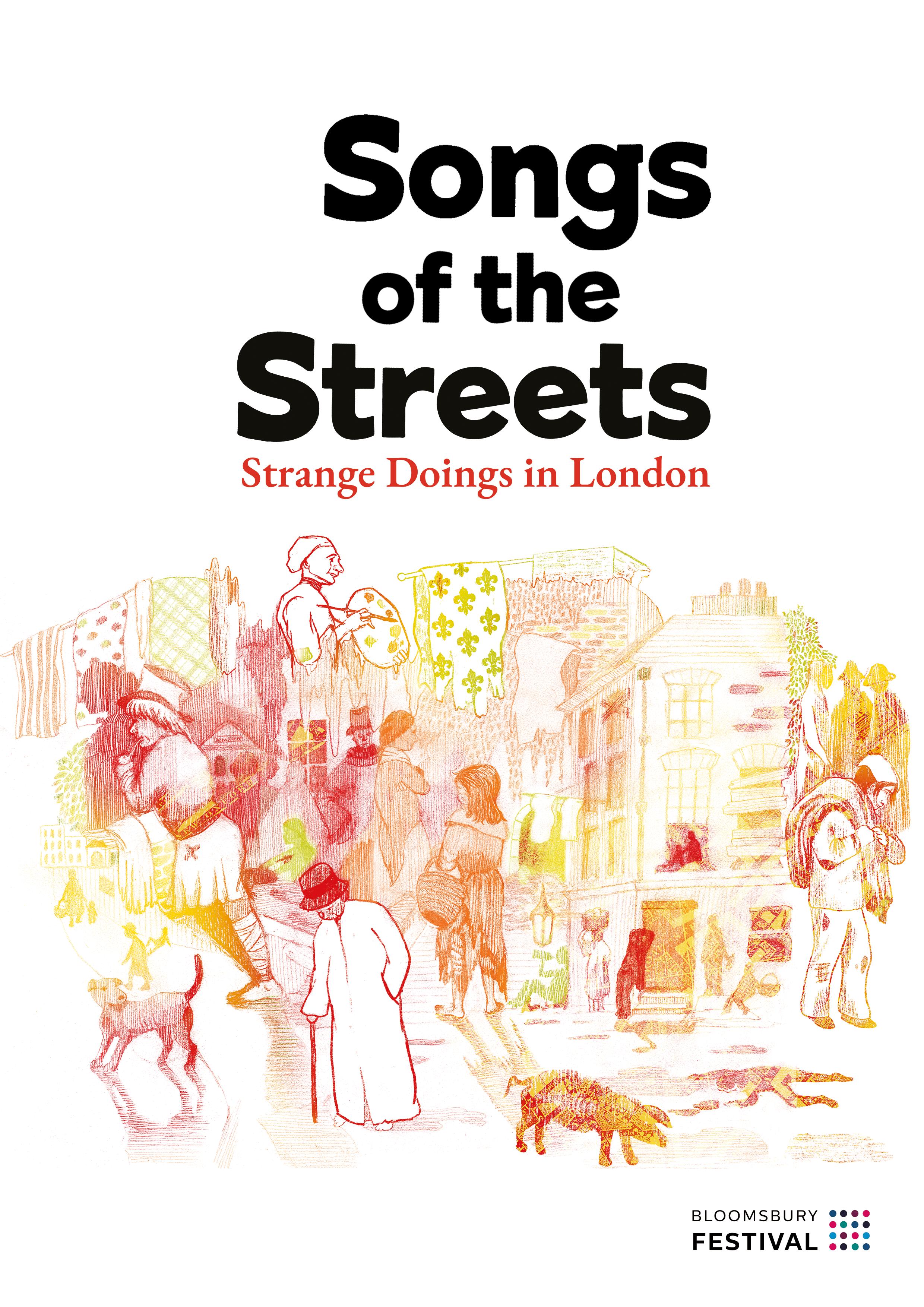




Strange Doings in London – The Ballads and Songs of St Giles set out to explore 1,000 years of history in the central London areas of St Giles and Bloomsbury through ballads, songs, artworks and exhibitions, leaving a legacy in the community of new research, music and artwork reflecting the history of the area.
The project was inspired by a commissioned book published in 2024, ‘St Giles-in-the Fields: The History of a London Parish’ by historians Rebecca Preston and Andrew Saint, which follows the ‘dense and tangled history’ from the twelfth century to today. As well as a place of worship, for centuries St Giles was an administrative centre for a district running from Lincoln’s Inn Fields, through Drury Lane and Seven Dials, to Tottenham Court Road and as far north as Gordon Square.
In 2023, Bloomsbury Festival Director, Rosemary Richards, sat down for a coffee with the Rector of St Giles-in-the Fields, the Reverend Thomas Sander, to learn about the new history book, and was amazed by the stories that the historians Rebecca Preston and Andrew Saint had unearthed. She was immediately inspired to bring these stories to a wider audience and involve local communities in sharing the knowledge of the place, the streets, and the people who walked on them, and lived by them, through the centuries.
Bloomsbury Festival Director
Rosemary Richards commented “As we sat talking across the road from the church, surrounded by the new architecture and tall modern buildings of St Giles Piazza, I could imagine myself back in the times of the street sellers, the plague victims, the ‘rookery’ dwellers who lived in poverty (described as having “the worst living conditions in all of London’s history” by Peter Ackroyd), and back to the start of the twelfth century when the first house of prayer was built on the site in 1101 by Queen Mathilda, the wife of Henry 1, who founded a leper hospital”.
The project has involved local communities, volunteers and choirs sharing the stories unearthed of the past lives on the streets we walk every day.
Volunteers were invited to work with the festival to research the ballads, street songs and artworks. Creating in response participants created new artworks, music recordings of ballads and songs, concerts of the music and exhibitions.
The researchers visited archives at the Charles Dickens Museum, the British Library, the British Museum, the University of Cambridge Library of Rare Books, and Camden Archives, delving into the archives to research ballads, news-sheets, literature and illustrations.

Vivien Ellis, the Musical Director of the project says “This has been a great opportunity for singers, local historians and researchers of all backgrounds to take part in a fascinating heritage project. We have been privileged to visit leading ballad archives and bring together different communities. And personally for me it is a journey to develop further the concept of Ballad Walks which I have now led in other areas including Southwark, Hull and Yorkshire and to continue my own research into work with choirs supporting wellbeing through singing”.

Street songs and ballads have been at the heart of this project exploring the history of St Giles and Bloomsbury. The year of research, musical and visual arts activities began in October 2024 with a concert at St Giles-in-the-Fields Church with singers, choirs and narrators introducing the stories and musical heritage of 1,000 years of the history of St Giles.
The 2024 Sing Ballads of Bloomsbury concert was a musical introduction to the history of St Giles-in-the-Fields, presented at Bloomsbury Festival 2024 with choirs from St Giles-in-theFields, the Dragon Cafe, singers Eleanor Cobb and Alex White and the Young Actors Theatre Islington.
The concert event in October 2024 was the launch of the year-long heritage project –Strange Doings in London, the Songs and Ballads of St Giles.
Scan QR code for the event recording
Local choirs and singing groups came together to share an evening of ballad singing, showcasing the history of the streets of Bloomsbury and St Giles, and the global cultures of communities who live here now. The lyrics of their ballads and songs are featured in this booklet, and the festival has recorded all the ballads performed and others from participating groups to be offered to the sound archive at the British Library and to the Camden Local Studies and Archives Centre.
This uplifting evening featured broadside ballads found in archives and set to their original music or other popular ballad tunes; new ballads composed and performed by local choirs; and traditional songs in the ballad tradition from East Asia, South America and the Caribbean.
Research into the broadside ballads was led by Vivien Ellis working with a group of volunteers brought together from the Dragon Cafe Singers, the Charles Dickens Museum, and Bloomsbury Festival.
Broadside ballads, narrative songs about newsworthy subjects, were set to popular melodies and sold cheaply on the streets, and can be considered the ‘social media’ of eighteenth and nineteenth century London, accessible and affordable for everyone. Seven Dials was the centre of the ballad printing industry, and these historic songs tell authentic stories of life on the streets, giving a unique insight into the rich and poor, health, crime and punishment in past centuries.
The performance was led and introduced by Vivien Ellis. The broadside ballads and Linstead Market were arranged and accompanied on accordion by Martina Schwarz.
Groups taking part in this event which featured live and recorded performances:
• The Morris Folk Choir (Live)
• Singers from the Rimanakuy Community Cultural Association (Live)
• Cor Meibion Gwalia Welsh Male Voice Choir (Recorded)
• London Chinese Community Centre Opera Group (Recorded)
• The Healing Voices Choir (UCLH and Great Ormond Street Hospital) (Live)
• Cecil Sharp House Choir (Live)
• Nossa Voz, a vocal group who meet to play and sing Brazilian music (Live)
• St Giles-in-the-Fields Church Choir (Recorded)
• Eleanor Cobb and Alex White (Recorded)
• Young Actors Theatre Islington (Recorded)
• Vivien Ellis (Live)
• Dragon Cafe Singers of the Mental Fight Club charity (Live)
• Helen McDonald (Live)
Also featured as audio recordings in the interval are:
• UCL Community Choir singing Waterloo Sunset by Ray Davies as sung by The Kinks
• The Good Companions singing Music Hall ballads and additional ballads from the Cor Meibion Gwalia Welsh Male Voice Choir and Brazilian singers Nossa Voz

Broadside ballads were how people found out what was going on from the 16th to the 19th century. They were the social media of the time, covering everything including celebrity, sensational crime, domestic life, world events, tragedy, humour, scandal, politics, and sport.
Ballads were the most common form of printed material, with millions produced. They were printed on one side of cheap paper, often decorated with woodcut images, and sold for a penny or halfpenny. Sometimes a tune-name was included on the sheet, but there was no need for written music. Everyone knew all the popular tunes and just picked up the melodies from the singing ballad sellers, who travelled up and down the country, to every hamlet, village, and town.
The ‘cartwheel’ streets of Seven Dials formed the centre of the ballad publishing industry, with printers such as Catnach, Pitts, Quick, and Paul, employing ballad writers known as ‘the Bards of 7 Dials’. These mostly anonymous hacks churned out songs to order, with ‘gallows ballads’ being a particular speciality.
I am inspired by how ballads can connect us to people, places, and events from the past, and how their rich variety can inspire new writing. From the beginning of human history, and across the world, before the advent of written language, songs told our stories and were the means of carrying our heritage from one generation to the next. There is no human group that does not have songs. They are our shared heritage and belong to us all.
I am grateful to the Bloomsbury Festival for the opportunity to research local ballads printed in Seven Dials with a wonderful group of volunteer researchers and to share our discoveries with people. The ballads we have found help us to hear the long-forgotten voices of people who lived in and around the diverse and impoverished Rookery of St Giles, to appreciate what mattered to them, what interested and amused them, what drove them to despair or gave them hope. I hope that these ballads can help us understand the legacy of the Rookery in aspects of our lives today and inspire our creativity in the future.

I am a Grammy-nominated early music specialist, community musician, researcher, and care worker interested in the intersection between music, embodied practice, and wellbeing. I have toured and recorded as a soloist with several acclaimed early music groups including Sinfonye, The Carnival Band, The Broadside Band, The Telling, the duo Alva, and The Dufay Collective. I am currently undertaking an MA in Music at the University of York. My postgraduate studies focus on my practice with people, music, and heritage, including ‘ballad walks’, a model I developed to connect us with places and each other through history, walking, and singing.
I developed ‘Creating Health’, an education for GPs in arts and health inspired by work with Mental Fight Club, which is published in the Journal of the RSPH. I am a member of the Natural Voice Network, an affiliation of singing leaders inspired by the work of Frankie Armstrong and united in the belief that everyone can sing. The Dragon Cafe is the flagship project of Mental Fight Club, a charity based in Southwark, and I lead The Dragon Cafe Singers, a weekly group supporting wellbeing through singing and songwriting in a relaxed social and creative cafe. We recently released ‘In This Circle is My Heart’, a Spotify album of collaborativelywritten original songs.
I am leading a number of participatory events in Bloomsbury Festival 2025, including ‘The Song of St Giles’, an illustrated talk with ballads co-presented with Jane Palm Gold at Holborn Library; ‘Songs and Ballads - A Singing Showcase’ with local choirs; and Ballad Walks of Dickens and 7 Dials in collaboration with Camden Guides. I also researched and recorded ballads and spoken word for ‘Quicken’, an outdoor art exhibition by Dryden Goodwin.
2025 Singing Showcase at Conway Hall introduced ballads old and new. The following pages provide details of the choirs and groups which took part and the ballads shared. This event was the opening concert for the Bloomsbury Festival 2025.
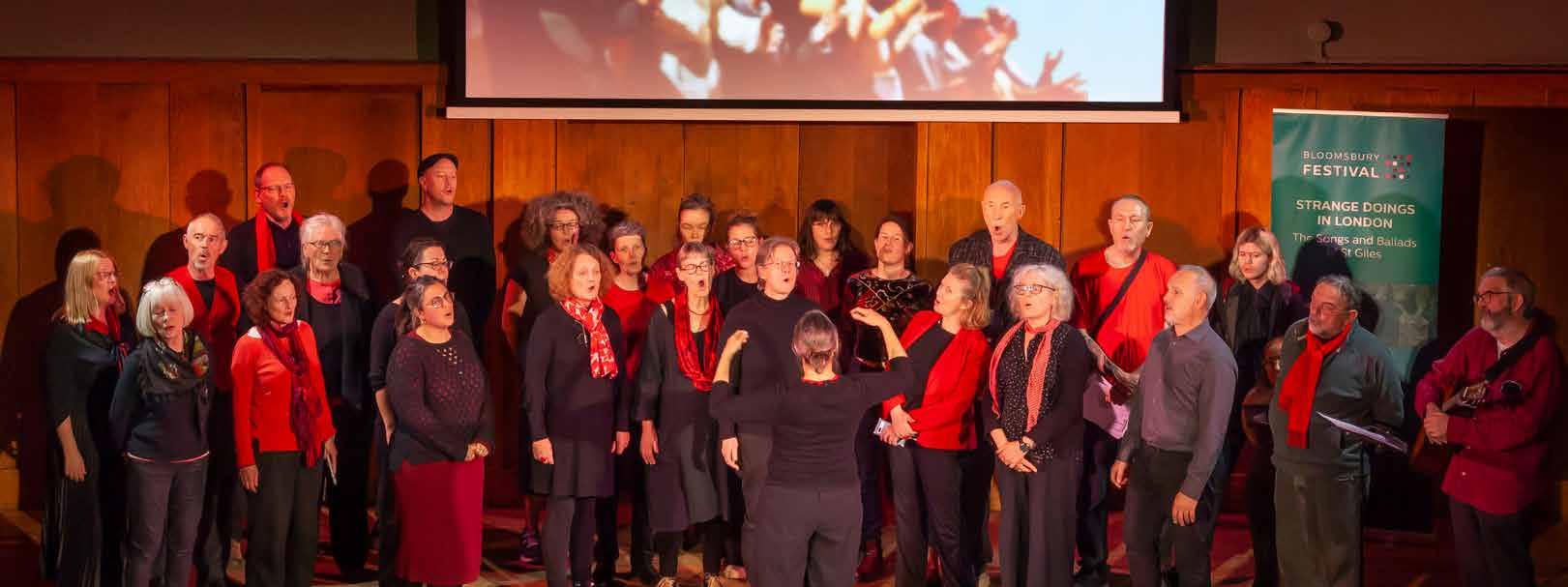
Since 2008, led by choir director Michelle Woolfenden, the Morris Folk choir have been coming together from all over London to learn and sing folk songs of all kinds - murder ballads, protest songs, work songs, sea-shanties, love melodies, folkified non-folk songs, and good old knees-up tunes, from all across the centuries and from all over the world.
The choir’s repertoire reflects the inclusive, internationalist, outward-looking nature of folk music: treasuring songs which have their roots in the tradition of local and national communities but which belong to anyone and everyone, embracing songs from one another’s traditions, and understanding that anything that has roots is living, growing and changing.
The Morris Folk Choir presented two ballads, one composed by a current choir member and the other by a choir alumnus.
The first song is called Better Days, by Iain MacDonald, which tells the story of one of the choir members, Seth’s grandmother Margaret “Pat” O’Connell, who left Ireland for Liverpool in the 1930s.
Their second song is composed by choir alumnus Tim Jones. The first lines came to him in the Betsey Trotwood pub after reading about the history of the St Giles’ Bowl: a bowl of ale which would be offered as a last tipple for the condemned on their way to the gallows. The choir now holds a monthly folk club at the Betsey so this song also reflects that connection.
Neither Tim nor Morris choir was aware of the other songs about St Giles so have been delighted to have been introduced to them as part of this concert!
by Iain MacDonald
Ireland was tough in the Thirties
She had to get out of its grip
To Liverpool she took her journey
And found love at the end of that trip
CHORUS: Don’t tell me about all your bad old days
Show me how you make the days better now
They got married and moved down to London
When they got there they learned how to teach
And then founded a school for the poor kids
That the ordinary schools couldn’t reach
CHORUS
They worked hard for peace and for justice
They worked to change times that were tough
And to help make life better for others
‘Cause to better yourself’s not enough
CHORUS
She was kindness and love and good humour
And though she’s twenty years’ gone
Her kids and their kids learnt from her
And the things that she taught them live on
CHORUS
Jones
I’ve given my body to vice and strong ale
I have drunk deep from this well
But don’t show me the door just yet my love
Stay your hand on the bell
Betsey, sweet Betsey you’ve stolen my heart
How can I return to my home?
There’s no more a welcome there for me
Surely it’s here I belong
CHORUS:
Surely it’s here I belong
Surely it’s here I belong
When the bell rings I will be leaving
But surely it’s here I belong
Oh come all you young men who play and sing,
My hands were once steady as yours
But now my voice is faltering
It’s not like the time before
Oh who’d be a drinking man these days
When there’s so much work to be done
We’ll empty the barrels in (the) Southampton
We’ll quarrel, we’ll fight and then some
CHORUS
Music and dancing were my first loves
The hops and the barley my last I’ve left this long and happy life
All for the want of a glass
So give me, oh give me that St. Giles bowl
I’ve one last place now to go
Bury me out in the barley fields
So I might return with the mow
CHORUS
Give me, oh give me that St. Giles bowl
I’ve one last place now to go
Bury me out in the barley fields
So I might return with the mow
CHORUS x 2
Live Performance
The Rimanakuy Community Cultural Association was formed in 2019 to conserve, promote and enjoy Andean culture and Quechua language.
Chinka Chinka
CHINKASUNMI NIWAPTIKI CHINKA
CHINKA LLIKLLACHAYTA QUPURAYKI, CHINKA CHINKA. HABLA: Y VIAJAMOS HASTA MI TIERRA APURÍMAC.
CHINKASUNMI NIWAPTIKI CHINKA
CHINKA LLIKLLACHAYTA QUPURAYKI
CHINKA CHINKA
MAYTAQ KUNAN CHINKANCHISCHU?
CHINKA CHINKA CHINKAYLLAPAS
MANA YACHAQ, CHINKA CHINKA

ESTO LO DICE HABLANDO.
CHINKASUNMI NIWAPTIKI
LLIKLLACHAYTA QUPURAYKI PABLUCHA, IMA HORAS KAMAN SUYASQAYKI, ÑAN CHIRIPAS ATIWANÑA PABLUCHA.
CHINKASPAQA CHINKASAQSI CHINKA
CHINKA, TAWA, PICHQA WATACHAPAQ
CHINKA CHINKA
YUYARISPA WAQANATAQ, CHINKA
CHINKA WAQAYKUSPA WAQANATAQ, CHINKA CHINKA.
HABLANDO: SUNQUYTA ATINQACHU PABLUCHA.
Runaway runaway
You said we going to runaway,runaway I gave you my beautiful shawl runaway runaway. Speaking. We travel to Peru my country. You said we going to runaway runaway I gave you my beautiful shawl runaway runaway [2 times]
Why now we did runaway ? runaway runaway to runaway we do not know how to runaway. [2 times] Speaking.
You said we going to runaway I gave you my beautiful shawl Paul, until what time I will wait for you I am already getting cold Paul.
If I runaway I will disappear runaway runaway for four or five years runaway runaway [2 times]
Remembering cry runaway runaway Crying weep runaway runaway [2 times] Speaks Paul you cannot my heart
Translated by Constantina Higbee
PIKICHA: CARNAVAL INTERPRETADO POR MILDER ORE
PIKICHA PIKICHA LARGO MAKICHA
WARMA YANACHAYWAN PUÑUCHAKUCHKAPTIY PATACHALLANMANTA KACHURAMUWANKI
AHORA ESO SI QANRA PIKICHA
RUMIPA PATAMPI TUSURACHISQAYKI MANDOLINACHAYWAN
TUKA TUKAYKUSPA RUMIPA
PATAMPI TUSURACHISQAYKI CHARANGUCHAYTA TUKA TUKAYKUSPA
QAMCHU YACHANKI ÑUQA YACHASQAYTA
PIKIPA MAKINMAN SURTIQA
CHURAYTA PIKIPA MAKINMAN CINTA CHURAYTA
AHORA ESO SI QANRA PIKICHA
RUMIPA PATAMPI TUSURACHISQAYKI MANDOLINACHAYWAN TUKA TUKAYKUSPA RUMIPA PATAMPI
TUSURACHISQAYKI GUITARRACHAYTA
TUKA TUKAYKUSPA
Little flea little flea [2 times]
When I was sleeping with my bride
You bite me from the edge of my bed [2 times]
Now this dirty little flea [2 times]
On top of the stone I will make you dance playing my mandolin once and again, again.
On top of the stone I will make you dance playing my little guitar once and again , again [2 times]
Do you know what I know?
To put a ring to little flea’s finger
Do you know what I know ?
To put a ribbon to flea’s hand
Now this dirty little flea [2 times]
On top of the stone I will make you dance playing my little mandolin
On top of the stone I will dance playing my little guitar once and again and again.
Translated by Constantina Higbee
Cor Meibion Gwalia is a Welsh Male Voice Choir based at the London Welsh Centre on Gray’s Inn Road. Founded in 1967, it is one of London’s oldest male choirs. The choir has performed in venues across the UK and Europe, including the Millenium Stadium in Cardiff, the Houses of Parliament, and the Royal Albert Hall.
They sand Wales’ best known love song, Myfanwy, with lyrics by Richard Davies and melody by Joseph Parry. The ballad has its origin in by the 14th century love story of Myfanwy, a noble lady, and the bard Hywel ab Einion. He fondly thinks she loves him but, alas, the romance is not to be and the song tells of his sorrow at being spurned
Paham mae dicter, O Myfanwy,
Yn llenwi’th lygaid duon di?
A’th ruddiau tirion, O Myfanwy,
Heb wrido wrth fy ngweled i?
Pa le mae’r wên oedd ar dy wefus
Fu’n cynnau ‘nghariad ffyddlon ffôl?
Pa le mae sain dy eiriau melys,
Fu’n denu’n nghalon ar dy ôl?
Pa beth a wneuthum, O Myfanwy
I haeddu gwg dy ddwyrudd hardd?
Ai chwarae oeddit, O Myfanwy
 thanau euraidd serch dy fardd?
Wyt eiddo im drwy gywir amod
Ai gormod cadw’th air i mi?
Ni cheisiaf fyth mo’th law, Myfanwy,
Heb gael dy galon gyda hi.
What was it that I did, Oh Myfanwy, To deserve the frown of your beautiful cheeks? Was it a game for you, Oh Myfanwy, This poet’s golden flame of love?
You belong to me, through true promise, Too much to keep your word to me?
I’l never seek your hand, Myfanwy, Unless I have your heart with it.
Why so the anger, Oh Myfanwy, That fill your dark eyes
Your gentle cheeks, Oh Myfanwy, No longer blush beholding me?
Where now the smile upon your lips
That lit my foolish faithful love?
Where now the sound of your sweet words, That drew my heart to follow you?
Performance
The Cantonese Opera Group are based at the London Chinese Community Centre in Soho and meet every Friday to sing and play Cantonese opera.
The name of the ballad they performed translates to ‘Lotus Fragrance’ and tells the story of a girl wishing to remain in love with her infatuated lover forever. The lyrics sing of the young woman looking at the moonlight reflected on the water of the lotus pond and smelling the fragrance of the lotus flowers. The ballad proclaims that love is like a lotus seed with a sweet but also bitter taste.
The Lotus Flower (Traditional)
The song describes a girl wishing to remain in love with her infatuated lover forever.
Love is like a lotus seed with the sweet also bitter taste.
荷花香 新月上
荷花愛着素衣裳
花香引得情蝶浪
怎禁它芬芳吐艷滿銀塘 身如明月呀留天上
夜夜塘邊照檀郎
情味是甜還是苦 郎情可似柳絲長 輕輕偎向檀郎問 你可知情到深時怕斷腸 花香那得千日艷 榴花結子便枯黃 人對花兒輕薄後 莫道花殘仍可肆意償 有情忍看花零落 花泣飄零淚滿塘
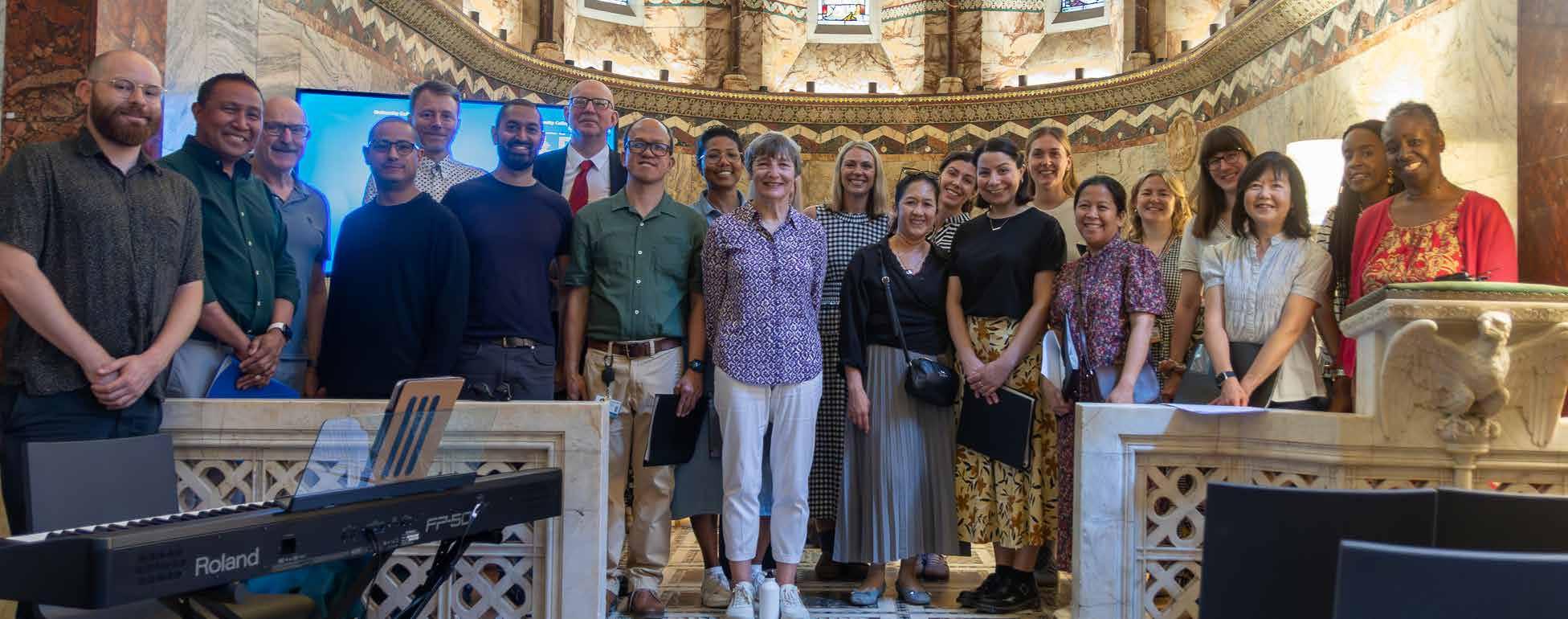
The Healing Voices Choir is made up of staff members across Great Ormond Street Hospital and University College London Hospitals NHS Foundation Trust.
Established in 2016, the choir meet weekly to sing together and have performed regularly across London (at venues like Fitzrovia Chapel and The British Museum) as well as at the hospitals.
The Healing Voices Choir sang a brand new ballad written especially for the Bloomsbury Festival. The ballad reflects the stories of the choir members and hospital workers, a snapshot of what it means to come together and sing.
Their second song is Way Over Yonder by Carole King.
The choir is jointly funded by UCLH Charity and GOSH Charity.


by N Hammerton & J McGrail
In the early evening we gather inside
We’ve travelled a long way from far and wide
We sing our refrain through joy and through pain
We unite together to sing again
Busy Streets
People rushing by out on the pavements
These hallways speak of many lives
Entwined in time, we share
Thought it’s not always easy I know there’s satisfaction in seeing it through We all need to have somebody to turn to And we’ll talk the highs and lows
I will be there when your heart aches I will hold on when you’re falling apart I will be there when you’re laughing Stronger as one when we sing together
Night and Day
I’ll be there when it feels overwhelming
This heavy load Lighter when you lean on me awhile
Thought it’s not always easy I know there’s satisfaction in seeing it through We all need to have somebody to turn to And we’ll talk the highs and lows
I will be there when your heart aches I will hold on when you’re falling apart I will be there when you’re laughing Stronger as one when we sing together
One voice, one heart, one goal
What matters is the love we hold
One song we sing together
I’ll be here through stormy weather
I don’t ever want to see you fall apart I will be here when the rain stops and the clouds part We will sing in unison and caring harmony
No you won’t be alone, no you won’t be alone
by Carole King
Way over yonder Is a place that I know Where I can find shelter From a hunger and cold
And the sweet tastin’ good life Is so easily found Way over yonder, that’s where I’m bound
I know when I get there
The first thing I’ll see Is the sun shining golden Shining right down on me
Then trouble’s gonna lose me Worry leave me behind And I’ll stand up proudly In true peace of mind
Talkin’ about Talkin’ about
Maybe tomorrow I’ll find find my way
To the place where the honey Runs in rivers each day
And the sweet tastin’ good life Is so easily found Way over yonder
That’s where I’m bound Way over yonder
That’s where I’m bound
Arranged and accompanied on accordion by Martina Schwarz
Where St. Giles’s church stands
One a lazar-house stood; And chain’d to its gates Was a vessel of wood.
A broad-bottom’d bowl from which All the fine fellows, Who pass’d by that spot On their way to the gallows, Might tipple strong beer, Their spirits to cheer
And drown in a sea of good liquor, all fear!
CHORUS: For nothing the transit to Tyburn beguiles, So well as a draught from the bowl of St Giles.
By many a highwayman many a draught
Of nutty brown ale at St. Giles’s was quaft, Until the old lazar house chanced to fall down, And the broad-bottom’s bowl Was removed to The Crown. Where the robber may cheer, His spirit with beer,
And drown in a sea of good liquor, all fear!
CHORUS: For nothing the transit to Tyburn beguiles, So well as a draught from the bowl of St Giles.
When gallant Jack Sheppard To Tyburn was led, “Stop the cart at the Crown, Stop a moment” he said He was offered the bowl, But he left it, and smiled, crying “Keep it ‘til call’d for by Jonathan Wild3. The rascal one day, will pass by this way And drink a full measure To moisten his clay
CHORUS: And never the transit to Tyburn beguile, So well as a draught from the bowl of St Giles.
Should it ever be my lot To ride backwards that way, At door the Crown I will certainly stay; I’ll summon the landlord, I’ll call for the bowl, And drink a deep draught To the health of my soul! Whatever may hap, I’ll taste of the tap, To keep up my spirits When brought to the crap; For nothing Bowl of St. Giles have beguiled, Such a thorough-paced scoundrel as Jonathan Wild
CHORUS: For nothing the transit to Tyburn beguiles, So well as a draught from the bowl of St Giles. INTERVAL – Audio recordings were played from UCL Community Choir, The Good Companions, additional ballads from the Cor Meibion Gwalia Welsh Male Voice Choir and Nossa Voz
From ‘Jack Sheppard – A Romance’ by William Harrison Ainsworth, serialised in Bentley’s Miscellany, Jan 1839–Feb 1840, reprinted as a broadside ballad by Seven Dials printers.

Cecil Sharp House Choir, directed by Ben See and run by the English Folk Dance and Song Society, sings an eclectic mix of beautifully arranged traditional and modern folk songs from Britain and beyond.
They sang The River Don’t Run, written by Richard Guard and Anna Crockatt, arranged by Rose Martin and The Outlandish Knight, a traditional song, arranged by Sally Davies.
Photo by Richard Lipman: Kings Cross Summer Sounds 2023
I was born on Paradise Row
Agar town: eighteen forty four
I fell in love with Eliza Brown
Her father ran the bar next door
And we went walking, by the river
She said she’d marry me for sure
We went walking by the river
But the river don’t run no more
But the river don’t run no more
My house came down eighteen sixty four
The two small rooms that I’d grown up in
To build the midland line from St. Pancras
Up to some place I’d never been
And we went walking, by the river…
You’ll not find Agar Town on any map
Now it’s all smoke and steel and din
And Eliza’s dad took a labouring job
And off she went then away with him
And we went walking, by the river…
I came back eighteen eighty eight
To try to find old Paradise row
And Eliza Brown with a tear in her eye
She said “I never wanted to go”
And we went walking, by the river…
Collected by Ralph Vaughan Williams in 1908 from Mr Hilton, South Walsham, Norfolk
Lady Margaret she sits in her bower sewing Ma ba and the lilly ba
When she saw the knight with his horn a blowing
On the very first morning of May
‘Oh I wish that I had that horn I hear blowing’
And it’s ma ba and the lilly ba
‘And that young knight to sleep here on my breast’
On the very first morning of May
Well the lady she had these words scarce spoke
And it’s ma ba and the lilly ba
When in at her window the knight come a jumping
On the very first morning of May
‘Oh strange it is, oh strange young woman’ And it’s ma ba and the lilly ba
‘I can scarce blow my horn since I hear you a calling
On the very first morning of May’
‘Go fetch you gold from your father’s table Deliver it unto me
And the two fastest horses in your father’s stable
Where there stand thirty and three”
So he’s mounted him on the black, black horse
And she’s rode on the dappled grey And they rode till they come to the broad sea shore
Just three hours before it was day
‘Lie down, lie down from your horse,” he says
‘And deliver it unto me
For it’s six pretty maids I have drownèd here And the seventh one you shall be’
‘Take off, take off your clothes,’ he says ‘And deliver them unto me
For they are too fine and costly robes For to rot in the salt, salt sea’
‘Lie down, lie down from your horse,’ she says
‘And turn your back on me
For it’s not fitting that any gentle man A naked lady should see’
So he’s mounted him down off his horse so high
And he’s turned his back on she
And she catched him around the middle so small
And tumbled him all down in the sea
Sometimes he sank, sometimes he swam And it’s ma ba and the lilly ba
‘Oh help, oh help, oh my pretty mistress Or drownèd I shall be’
‘Lie there, lie there oh you false young man
Lie there instead of me
For it’s six pretty maids you have drownèd here
And the seventh one has drownèd thee’

Nossa Voz are a vocal group who meet to play, sing and celebrate Brazilian music and culture.
‘What links us all is our love to sing Brazilian music and celebrate Brazilian culture, within an original and slightly unconventional project, mixing voices and musical arrangements with theatrical elements, even though the majority of the group had never set foot on a stage before joining’
by Chico Buarque & Milton Nascimento, 1977)
Debulhar o trigo
Recolher cada bago do trigo
Forjar no trigo o milagre do pão
E se fartar de pão
Decepar a cana
Recolher a garapa da cana
Roubar da cana a doçura do mel
Se lambuzar de mel
Afagar a terra
Conhecer os desejos da terra
Cio da terra, a propícia estação
E fecundar o chão
Nossa Voz has the objective of showing the richness and diversity of Brazilian Popular Music to the British public, including in their repertoire songs from many composers, taking their audiences on a musical journey.
The group is always open to new members, regardless of experience or nationality. www.nossavoz.org
Winnow the wheat
Harvest every grain of wheat
Shape the wheat into the miracle of bread
And gorge oneself on bread
Sever the cane-stalk’s head
Harvest the juice from the cane
Steal the syrup sweetness from the cane
Smear oneself in syrup
Caress the earth
Know the earth’s desires
Lustful earth, season of promise
And inseminate its soil
by Luiz Gonzaga / Humberto Teixeira, 1947
Quando olhei a terra ardendo
Qual fogueira de São João
Eu perguntei a Deus do céu, ai Por que tamanha judiação
Que braseiro, que fornalha
Nem um pé de plantação
Por falta d’água perdi meu gado Morreu de sede meu alazão
Até mesmo a asa branca
Bateu asas do sertão
Então eu disse adeus Rosinha
Guarda contigo meu coração
Hoje longe muitas léguas
Numa triste solidão
Espero a chuva cair de novo Para eu voltar pro meu sertão
Quando o verde dos teus olhos
Se espalhar na plantação
Eu te asseguro não chores não, viu
Que eu voltarei, viu, meu coração
As I saw the land all blazing
Like the flames of Saint John’s fire
I cried to God, up there in heaven
Is this, our torment, what you desire?
In that inferno, that raging hell-fire
The fields lay barren, dry and bare
I lost my cattle for want of water
Thirst killed my pony, my chestnut mare
And the white-winged birds departed
Took flight and left these desert lands
And so I said farewell, Rosinha
My heart stays with you, safe in your hands
Far away now, sad and lonely, I sit here hoping it will rain
And when that day comes, I will return, love
And see my fair homeland again
When the fields have all turned green again
Like the colour of your eyes
There’ll be no need, my love, for tears then
I’ll be back with you, right by your side
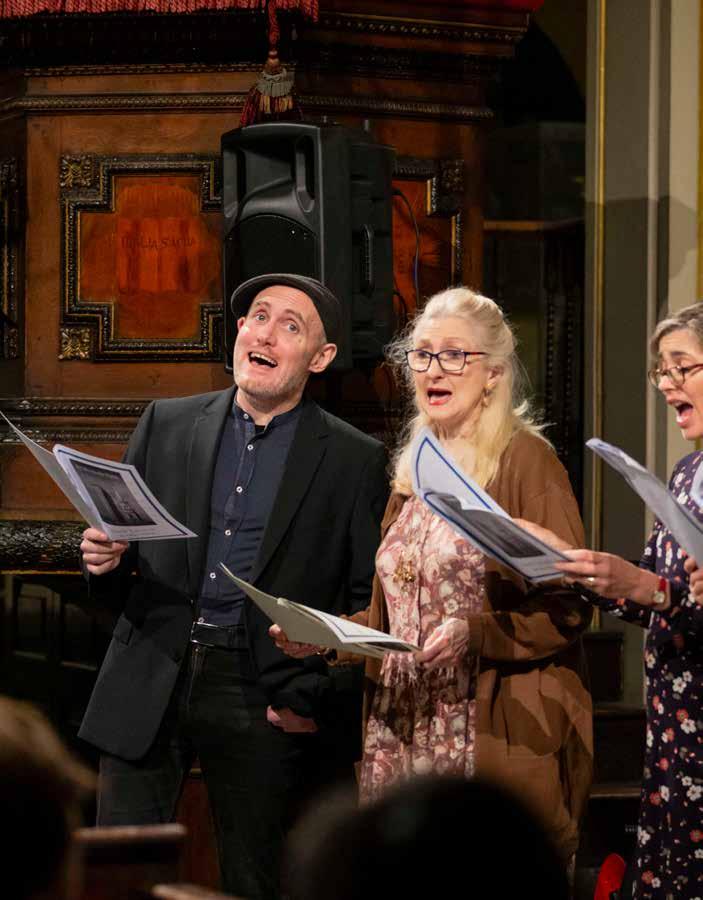
One Mrs Mary Whistle as we hear, Who was a Housekeeper for many a Year, In St Giles’es in the Fields many does know, But by Misfortunes was Reduc’d to Low.
That to the Parrish for Relief she went, And to the Parrish work-house she was sent, Tho’ she to Workhouse had ne’er been taught, Yet there to Card or Spinn she must be brought.
There for Eleven Weeks poor Soul she lay, Half Sterv’d, Eat up, with Vermin (as they say) Holes in her Legs her Arms her hips and Thighs The Vermin eat and in her Head likewise.
Her Hair was matted with the Vermin so, The like before no one did ever know, A filthy sight, alas, for to be seen, What Misery must this Poor Soule die in.
The St Giles Choir is a volunteer choir. It leads worship at the 6.30pm Sunday evening services, meeting beforehand at 5pm to rehearse the settings, hymns and anthem to be sung that evening.
Under the encouraging leadership of our director of music they have gone from strength to strength over recent years and now number some 25 in all. Whilst some members have music training, most have not, but can read music and lend their own voices to that of the ensemble.
Jonathan is always pleased to hear from new singers who might like to join and will offer a voice test first.
The St Giles Choir have also sung for evening worship at Portsmouth, Chichester, Winchester, Southwark and Norwich Cathedrals, as well as for local charitable causes.
Broadside Ballad printed c.1730 for ‘Christian Love-Poor, near St Giles’s Church, London’, giving an account of the death in St Giles Workhouse of Mary Whistle, ‘a good housekeeper of St Giles’, through abuse and mismanagement. British Library, ESTC T12587
Tune: ‘Death and The Lady’.
(Recorded) October 2024 Opening Concert - Sing Ballads of Bloomsbury at St Giles-in-the-Fields Church
Written at No 20 Denmark Street, close to St Giles-in-the-Fields Church, reflecting the continuing music tradition of the area in the 20th century.
(Recorded) October 2024 Opening Concert - Sing Ballads of Bloomsbury at St Giles-in-the-Fields Church
Young Actors Theatre Islington is a vibrant performing arts charity dedicated to dramatically changing young people’s lives. It offers exceptional, high-quality training, exciting short courses, and free performance opportunities for those aged 4+. Through its outreach work, YATI brings the magic of theatre into local communities, ensuring the many positive benefits of drama are accessible to all.
Consider yourself at home
Consider yourself one of the family
We’ve taken to you so strong
It’s clear we’re going to get along
Consider yourself well in
Consider yourself part of the furniture
There isn’t a lot to spare
Who cares? Whatever we’ve got, we share
If it should chance to be
We should see some harder days
Empty larder days, why grouse?
Always a chance we’ll meet somebody to foot the bill
Then the drinks are on the house
Consider yourself our mate
We don’t want to have no fuss
For, after some consideration, we can state
Consider yourself one of us

Consider yourself at home
Consider yourself one of the family,
We’ve taken to you so strong
It’s clear we’re going to get along
Consider yourself well in
Consider yourself part of the furniture
There isn’t a lot to spare
Who cares? Whatever we got, we share
Nobody tries to be la-di-da and uppity
There’s a cup of tea for all
Only it’s wise to be handy with a rolling pin
When the landlord comes to call
Consider yourself our mate
We don’t want to have no fuss
For, after some consideration we can state
Consider yourself one of us
Consider yourself one of us
Consider yourself one of us

The Dragon Café provides a unique, relaxing and creative space open to all every Monday, both online and in various physical spaces in the Borough of Southwark. It is the flagship project of Mental Fight Club, a UK-based arts and health charity providing creative and social support to people experiencing mental ill-health, through a range of imaginative events and activities. Since 2013 The Dragon Café Singers, led by Vivien Ellis, have written songs collaboratively. In July 2025 they released ‘In This Circle Is My Heart’, an album of 12 original songs, available on Spotify. The Ballad of The Dragon Café is inspired by traditional ballads, and tells the story of Mental Fight Club, and its inspirational founder Sarah Wheeler, from the point of view of Café patrons.

The Ballad of the Dragon Café by the Dragon Café Singers with Daniel O’Byrne, Sionie Kirtley, Vivien Ellis and Glenn Keiles
Arranged and accompanied on accordion by Martina Schwarz
Chorus:
Too Ra Loo Ra Ay
Too Ra Loo Ra Ay
I heard about the Dragon Café
One bright blue Monday morn; A friend he told me all about it At fitness class and core. He said to me you’ll like it I know, Much more than you do here; I’ll tell you more about, it I will, So please lend me your ear.
Chorus:
Too Ra Loo Ra Ay
Too Ra Loo Ra Ay
1. A holiday, a holiday, The first day of the week, Thanks to Sarah, we come together, To have a time to speak. We welcome all to heed the call And join in with our song; To come together and be together, Together, we are strong. Lost in London, feeling undone. Found the Dragoniers; To raise my spirits, to higher limits And wash away my fears. When at my lowest
At my remotest, when I was all alone; There was a place and a friendly face, I’d finally found a home.
CHORUS:
Oh, oh, Dragon Café, How we love you so, Oh, oh Dragon Café, The place we love to go; Oh, oh, Dragon Café, Bring all that’s in your soul; Oh, oh, Dragon Café, How we love you so.
2. Sarah Wheeler was her name, Founder of the DC. Seeking change for mental health, She was a visionary. She laughed out loud, Her head thrown back, A sound we won’t forget; She’d welcome all with kindly eyes, And smoke her cigarette; Through Sarah’s vision, We keep the mission, To give a voice to all. Through art and song, We are made strong, And we can all stand tall.
To try to change Psychiatry We’d have evening debates; To have a voice where silence was, The shift it can create.
CHORUS:
Oh, oh, Dragon Café, How we love you so, Oh, oh, Dragon Café, The place we love to go; Oh, oh Dragon Café, Bring all that’s in your soul, Oh, oh, Dragon Café, How we love you so.
3. All through Lockdown, projects ran, With so much we could do; Every week we danced and sang It helped us to get through. In networked webs We strengthened bonds
To keep community; The good remained From what had gone, We had a place to be. I was living on my own, Alone and full of strife; Zooming with the Dragoniers Really saved my life. I didn’t feel so on my own, I found a special space; Through a million pixels, glowing bright, Shone every friendly face.
CHORUS:
Oh, oh, Dragon Café, How we love you so, Oh, oh, Dragon Café, The place we love to go; Oh, oh Dragon Café, Bring all that’s in your soul, Oh, oh, Dragon Café, How we love you so.
4. Those who are not with us still Live on through legacy; We paint their lives in verse and rhyme And in our memory. Sarah Wheeler would be thrilled Our café is alive; She may be the angel Making sure that it survives. Each silver lining has its cloud, Different yet the same; Every that which is no more, Each loss doth have its gain. The future is uncertain, And things may well still change; We’ll stay together as family, Dragon Café will remain.
CHORUS:
Oh, oh, Dragon Café! How we love you so, Oh, oh, Dragon Café! The place we love to go; Oh, oh, Dragon Café! Bring all that’s in your soul, Oh, oh, Dragon Café! How we love you so.
The Last Farewell to St Giles (Broadside Ballad)
Tune: ‘Pop Goes The Weasel’ Arranged and accompanied on accordion by Martina Schwarz
OH ! here’s a pretty go, Bawls out old mother Miles, They are going to send us all to pot, And pull down all St. Giles’s, She begged they would not serve her so, But favour they denied her, What a slaughter there will be among, The bugs, the fleas, and spiders.
CHORUS:
If stones and bricks & floors could speak, They would lay down before ye, Concerning famed St. Giles’s tricks, A very pretty story.
Old mother Flynn began to sing, Boys, I don’t care a farden, They are going to pull down Drury Lane Charles Street, and Short’s Gardens ; Up and down and right around, And all the Seven Dials, The bugs and fleas of all degrees, Are bawling poor St. Giles’.

Since sweet Saint Giles’s first was built, There’s many years gone over, Saint Giles’s once was all alive, And people lived in clover, But now she is condemned to die, As dead as any gander. Cries Tommy Grout I’m up the spout, Wherever shall I wander.
Her glass is run, her time is come, Oh dear ! says Mrs. Miles’ Bad luck to them who did invent, To murder poor Saint Giles’s, Oh sweet Saint Giles’s I’m afraid, You will be hung drawn and quartered Poor Tommy Grout is up the spout, And all his houses slaughtered
Broadside ballad printed by Thomas Birt, 39 Great St Andrews St Seven Dials between 1833 and 1851, held at the Bodleian Library, Oxford.
Helen is a professional singer, songwriter and band member of Future Groove, and sings with Yaaba Funk and Maucusi Players. She also sings with the Dragon Cafe Singers and is shared a traditional Caribbean song Linstead Market

Oh, carry me ackee, go a Linstead Market
Not a quattie would sell
Oh, carry mi ackee, go a Linstead Market
Not a quattie would sell
CHORUS:
Lord, what a night, not a bite
What a Saturday night
Lord, what a night, not a bite
What a Saturday night
Oh, everybody come feel up, feel up
Not a quattie would sell
Everybody come feel up, feel up
Not a quattie would sell
CHORUS:
Lady buy you Sunday morning breakfast
Yam and Akee nyam gran
Make me Call i Louder
Akee Akee
Red and pretty demtan
CHORUS:
All the Pickney come Linger Linger
For what the mamma no bring
All the Pickney come Linger Linger
Oh how the Pickney they feed
CHORUS:
Oh, carry me ackee, go a Linstead Market
Not a quattie would sell
Oh, carry mi ackee, go a Linstead Market
Not a quattie would sell
Following research of the ballads Vivien Ellis created two ballad walks working with Camden Guides Association. One featured the area of St Giles and Seven Dials, the other started at the Charles Dickens Museum and led to the Foundling Museum. A selection of the ballads from the walks can be found here.
Where St. Giles’s church stands once a lazar house stood And chain’d to its gates was a vessel of wood. A broad bottom’d bowl from which all the fine fellows Who passed by that spot on their way to the gallows Might tipple strong beer, their spirits to cheer And drown in a sea of good liquor all fear!
CHORUS:
For nothing the transit to Tyburn beguiles So well as a draught from the bowl of St. Giles.
Broadside ballad printed in Seven Dials, 1840 Tune: ‘Packington’s Pound’ Theme: Jack Sheppard (1702-1724), notorious thief who stopped at the pub for a bowl of ale on his way to execution at Tyburn. Location: The Angel, St Giles High Street.
A kiddy girl born near St Giles, A pretty little mudlark, Who loved to chant a flashy song, and could imitate a dog’s bark. She prigg’d a little tarrier, His name was Muzzy Tandy, he was planted underneath her cloak When she went in search of Sandy.
CHORUS: Bow, wow, wow, Fol de riddle i do. Bow, wow, wow.
Broadside ballad printed in Seven Dials, early 1800’s Tune: ‘Bow Wow Wow’ Location: by The Crown pub, Seven Dials.
A true relation of seven modern plagues or visitations in London
An approved remedy against the Plague: Take a sprig of Rue, alias herb-of-grace, and shred it, and put it in a Figg or two, And eat it every morning fasting, it keeps the Body from infection, and purifieth the bloud. Reader whatever thou art, rich or poor Rowse up thyself, for death stands at the door, If God says strike, he must, and will come in, For death we know, is the reward of sin.
Broadside ballad published in Edinburgh, 1665
Tune: ‘Fortune my Foe’ (suggested by Vivien)
Physical location: National Library of Scotland - Rare Books
Themes: bubonic plague of 1664-1665 started in St Giles; squalid living conditions
Location: Resurrection Gate, church of St Giles
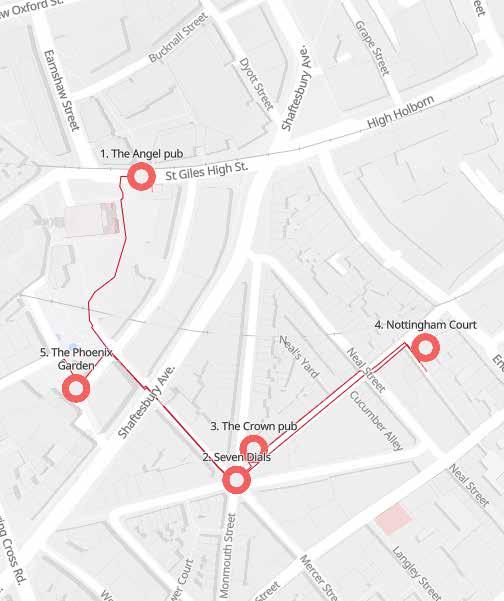
What a row and a rumpus there is I declare, Tens of thousands are flocking everywhere, To petition the Parliament, onward they steer, The Chartists are coming, oh dear, oh dear.
To demand equal justice, their freedom and right, Pump-handles and broomsticks, lawk, how they can fight! The nation, they say, is o’erwhelmed with grief: A peck-loaf for two pence and four pounds of beef.
CHORUS:
Hurrah for old England and liberty sweet, The land that we live in and plenty to eat; We shall ever remember this wonderful day, The Chartists are coming, get out of the way.
Broadside ballad printed in Seven Dials, c.1848. Tune: ‘The Campbells are Coming’
Themes: Great Chartist Meeting on Kennington Common, April 10, 1848; William Cuffay Black Chartist leader; political organisation in the Rookery
Location: Seven Dials
White sands and grey sands Who’ll buy my white sands Who’ll buy my grey sands
Traditional round based on a street cry
Theme: Mr Pancks sang this in Little Dorrit
Location: Dickens Museum, Doughty Street
Ben was a Hackney Coachman rare, Jarvey, Jarvey, here am I, your honour. Crikey! how he used to swear Tomarroo, Tomarroo. How he’d swear and how he’d drive, Number three hundred and sixty-five! Rum tum tiddle idle, hey gee, wo!
Anon, from a 19th century broadside ballad from Holborn Library. Printed by T Birt, Seven Dials.
Link: Doughty Mews was home to coachmen and their horses, like the coachman employed by Dickens.
Location: Doughty Mews
Tune: ‘Strawberry Fair’

Now Gals and Boys I hopes you’re vell And thank you I’m the same, Of course ye don’t know me not at all But the Dodger is my name You’ve read my adwentures writ by “Boz” (I say who the Dicken’s is he?) About a Parish ‘prentice lad Who vos “All-of-a-twist like me”
CHORUS:
Then fare-ye-vell Vhitechapel Boys, And farevell all my fren’s I’m going avay for the good of my ‘ealth But not at my own expense.
Written by Charles Sloman and Sam Cowell. Held in the Miller Collection of sheet music Dickens Museum.
Link: Oliver Twist written at 48 Doughty Street
Location: Dickens Museum, Doughty Street
My name’s “Poor Jo” A waggerbone am I A beggar I’m called by the rich I couldn’t have no father
Nor mother I suppose, For I never know’d nothink of sitch!
I’m werry muddy Gents, And ragged too I knows, And my hair has bin mistook for a mat!
I’m chivvied by the bobbies
Run over by the cabs
And life aint wery nourishing at that!
CHORUS:
Then Gents, if over my crossing you go, Chuck me a copper, I’m only “Poor Jo!” Then Gents, if over my crossing you go, Chuck me a copper, I’m only “Poor Jo!”
I’ll sing you a new ballad, and I’ll warrant it First-rate,
Of the days of that old gentleman who had that old estate;
When they spent the public money at a bountiful old rate
On ev’ry mistress, pimp, and scamp, at ev’ry noble gate,
CHORUS:
In the fine old English Tory times; Soon may they come again!
by
Charles Dickens, pub. Aug. 1841
Link: Dickens wrote this satirical ballad to the tune, and following the form, of a popular tune ‘A Fine Old English Gentleman’.
Location: Mecklenburgh Square
Written by H.B.Farnie
Composed by C.H.R. Marriott
Theme: Jo is a crossing sweeper in Bleak House
Location: Near Coram Fields.
They told him gently she was gone, And spoke of Heav’n and smil’d, And drew him from the lonely room, Where lay the lovely child.
‘Twas all in vain, he heeded not, Their pitying looks of sorrow, ‘Hush, hush!” he said, “she only sleeps She’ll wake again tomorrow
CHORUS (last two lines of each verse are repeated as the chorus):
‘Hush, hush!” he said, “she only sleeps She’ll wake again tomorrow’.
By George Linley
Link: Dickens’s favourite, sung to him by his daughter Mamie.
Location: St George’s Gardens.
Our light our Saviour is the Lord, For nothing need we care; The mighty Lord is our support, What need we then to fear? When parents yielding to distress Their helpless Charge forsook; Then nature’s God look’d down to bless, And Pity on us took. Continue then to hear our voice, When unto thee we cry; And still the Infants praise receive, And still their Wants supply.
From the Foundling Chapel Hymn Book 1774, held in Camden Local Studies Archive
Link: Dickens was a regular member of the congregation of the Foundling Chapel.
Location: Tracey Emin sculpture of a child’s mitten on the railings outside the Foundling Museum
Mae Russell is a Ballads and Song Research Volunteer, taking part in the Strange Doings in London project run by Bloomsbury Festival and supported by the National Lottery Heritage Fund.
The Strange Doings in London heritage project is about rediscovering the forgotten voices of history –voices carried not in books, but in ballads and songs that once filled the streets of St Giles. The project seeks to uncover these lost narratives, using oral traditions, literature, and community research to breathe life back into stories that might otherwise fade away. This first research visit to the Charles Dickens Museum felt like stepping into one of those stories.
The historic Parish of St Giles stretched from Lincoln’s Inn Fields through Covent Garden and Seven Dials, towards Tottenham Court Road. This area, now a bustling part of London, was once home to a leprosy hospital, public executions, and mass graves from the Great Plague of 1665. The infamous Rookery – a dense network of alleyways and tightly packed housing – became a refuge for those excluded from wealthier parts of the city. While it was often described in terms of crime and poverty, it was also a vibrant, self-sustaining community where people supported one another. It had a strong Black presence, with freed and escaped enslaved individuals settling there, and it was home to sex workers, migrants, and others who carved out lives in difficult conditions. It was a place of survival, where communities found ways to endure despite the vast social inequalities surrounding them. Thousands lived in overcrowded conditions, while just streets away, London’s elite thrived in comfort. These parallel worlds of privilege and struggle are reflected in both Dickens’ writing and the ballads of the time – each serving as a record of lives that history often forgets.
St Giles was deeply woven into Dickens’ life and works, just as it was into the ballads of the time. The streets he walked – where he observed both the grandeur and the squalor of London – are the same streets that inspired so much of his fiction.
Dickens was fascinated by the characters who occupied the fringes of society, the same figures who often became subjects of ballads and street songs. Many of these songs were about criminals, orphans, workers, and those struggling to survive – figures he immortalised in books like Oliver Twist and Bleak House.
Much like Dickens’ novels, ballads were not just entertainment – they were commentary, satire, and social critique. They spread news, carried warnings, and reflected public sentiment. Just as Dickens used literature to highlight the injustices of child labour, workhouses, and slum conditions, ballads carried these same stories in musical form, passed from person to person on the streets of London.
The heart of our session was the ballads themselves. Emma Harper shared copies of original ballads, allowing us to see firsthand how these songs recorded history in a way that was never meant to last. Vivien Ellis, a ballad singer and researcher, introduced us to a selection of songs that had been inspired by Dickens’ characters – such as The Artful Dodger, Dolly Varden, and Poor Jo. These songs acted as another layer of storytelling, carrying Dickens’ narratives beyond the page and into the streets, music halls, and homes of working-class Londoners.

Although the session took place in 49 Doughty Street, after it ended, we were free to explore 48 Doughty Street – Charles Dickens’ actual home. I took the opportunity to walk through his rooms, seeing his personal belongings and imagining him at work. Being in that space allowed everything I had just learned to settle in and feel real. The contrast between discussing Dickens’ world in a research setting and then stepping directly into the place where he lived and wrote was powerful. It was a reminder that history is not just something we study – it is something we step into, something we feel.
Our research into these forgotten songs is only just beginning. This project is about piecing together history through collaboration – researchers, musicians, historians, students, and local communities coming together to recover stories that were nearly lost. Just as Dickens’ books were read aloud to those who couldn’t read, these ballads were meant to be sung – shared, reshaped, and remembered. Through this project, we are not just studying history – we are bringing it back to life. And as we continue to unearth the strange doings of London, we’ll keep listening for the echoes of the past, hidden in the melodies of forgotten songs.
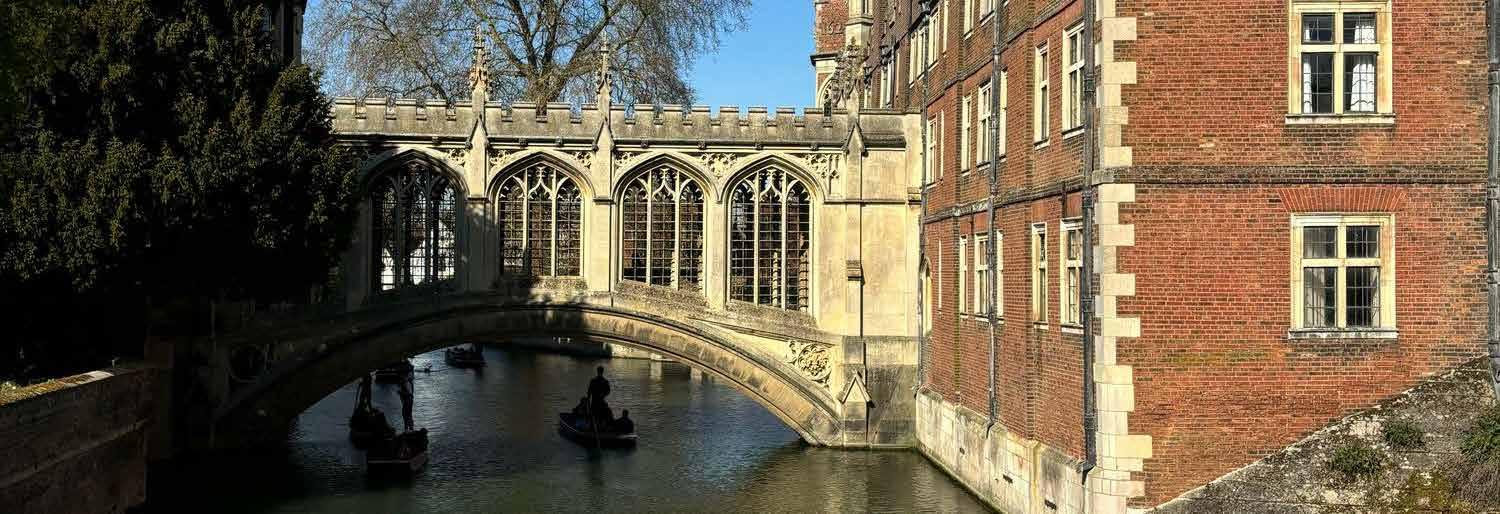
By Mae Russell
Our second research session for the Strange Doings in London heritage project brought us to the Rare Books Department at the University of Cambridge Library, where we explored the Madden Collection, an expansive archive of printed ballads. Unlike our guided and performative experience at the Charles Dickens Museum, this session was rooted in exploratory research. It gave us the chance to approach the material directly, without narration – just us, the pages, and the quiet of the reading room.
We were introduced to the collection by Dr Liam Sims, Rare Books Specialist, who welcomed us and offered a brief overview of the library’s holdings. He explained how these ballads, once considered too common or lowbrow to collect, are now recognised as rare and important sources of social history. Many survived by chance, rescued just before the print shops closed. Some pieces have only recently been catalogued, showing how active this work of recovery still is.
This made the experience feel especially meaningful. We weren’t just handling historical documents – we were engaging with materials that had nearly disappeared from the record altogether. Vivien Ellis, a ballad singer and researcher who is leading this heritage project, encouraged us to take full advantage of the opportunity to closely observe the pages themselves: their layout, texture, and typography. At the Charles Dickens Museum, we’d heard the ballads performed and discussed. Here, we were asked to study them first-hand.
The quiet atmosphere in the room reflected both concentration and a bit of awe. For many of us, it was our first time working directly with archival items of this kind. We carefully turned the delicate pages, comparing ballads, tracing themes, and sharing findings. One thing
that stood out was how many ballads combined prose and verse – beginning with a brief written account of an event, followed by a lyrical retelling. It was a reminder of how intertwined storytelling and singing have always been.
The subjects ranged widely – from crime, political affairs, socioeconomic debrief, public hangings, and hardship to marriage, gossip, and satire. They captured snippets of London life from the perspective of ordinary people. Some ballads noted the tune to which they were meant to be sung, but most didn’t. As Dr Sims explained, all the ballads in the collection would have had melodies – but unless passed down orally, those tunes have largely been lost. And because these prints weren’t considered important enough to archive systematically, many remain unrecorded or uncatalogued even now.
The final part of our visit took us into the library’s printing press room. Here we saw original presses, type blocks, and the physical tools that would have been used to create the ballads we had just been reading. It brought everything full circle. These weren’t elite or decorative texts. They were made quickly, distributed cheaply, and designed to be read aloud, sung, and remembered – or forgotten. Yet somehow, many survived.
This session offered a different way of researching, one that placed the materials in our hands and trusted us to find meaning through looking, asking, and reading. It reminded me that heritage work is often as much about recovery as it is about preservation. And sometimes, the act of seeing a sheet of paper – torn at the edges, a printer’s name still visible, a forgotten tune once carried in its lines – can say more than any explanation ever could.
By Jessica Wall
Jessica Wall is a Ballads and Song Research Volunteer taking part in the Strange Doings in London project run by Bloomsbury Festival and supported by the National Lottery Heritage Fund.
The final research visit of Strange Doings in London took the group to the prestige setting of the British Library. Hosted by Dr Rupert Ridgewell, Lead Curator of Printed Music, the group was ushered through the library’s vast, ever busy atrium, across its roof terrace and into a special room. Two presentations on the archives relevant to us had been prepared and the tables around the room held specially selected books, nestled cosily on little cushions ready for any bibliophile’s perusal. These weren’t just books, these were British Library books.
It felt like a special privilege that these fantastic materials had been prepared for us and was more than I had been expecting. The first presentation was by Michele Banal, Lead Curator, World and Traditional Music, “Folk Song and Music Recordings in the British Library Sound Archive.” The archive holds a mind boggling amount of recordings, over seven million, of speech, music, wildlife and the environment, dating from the 1880s until the present day. These are carried on wax cylinders; shellac, lacquer and vinyl discs; open reel and compact cassettes; compact discs; and digitally. The collection has been donated by scholars, musicologists and anthropologists.
Though London voices were few, we heard some transporting recordings. They were recorded in the 1950s but the singers were old so they were a gateway to older times still.
The second presentation concentrated on printed music at the library, a collection of around 1.6 million items from 1501 to the present day, including sheet music and para-textual information. Dr Ridgewell had picked out some especially interesting items to show us: the impenetrable Harmonic Diagram invented by C. Wheatstone which remains a mystery to everyone but the creator himself to this day; experiments in music notation; rare or unique sheet music in the collection; and the jaunty and very British song Monday was the Day (Ev’ry Pub We Saw We Went Inside It).
There followed time for the group to look over the items that had been selected for us. The large books were treated with reverence and there was some disbelief in the group that we could handle them. Amongst the pages, I was taken with the enchanting Woodlark Rondo, a piece where the musician had notated the bird’s song with an etching of the artist themselves above it. We got to handle a wax cylinder dating from 1908, marvelling at the physical grooves that become sound waves.
To finish the session, Vivien sang, bringing the ballad from its page bound slumber into the air surrounding us. It was a wonderful experience and a fitting end to an enchanting project.

By Mae Russell
Tucked quietly above the hum of the Holborn Library sits the Camden Local Studies and Archives Centre - a space that holds centuries, not just of paper and ink, but of people. Here is where our third session with the Strange Doings in London heritage project took place. A visit that felt different from the previous - more grounded. We were looking at the records of the area, in the areaand that proximity made everything feel more immediate, more real.
We were welcomed by Senior Archivist Tudor Allen, whose care and enthusiasm for the material shaped the day. He and his team had prepared an array of documents, books, prints, and ballads specifically for our project, drawing a line through time from the parish of St Giles to the pages in front of us.
Tudor told us plainly: many records once dismissed as unimportant or too commonplace have since been lost.
Among the most moving moments of the visit was the chance to examine a selection of historical ballads - preserved in a small box, their pages so thin they felt like air. Vivien Ellis, ever our musical compass in this work, even sang one aloud. One moment stood out: Vivien spotted a ballad titled Bushes and Briars and recognised it immediately. It
was one she had known for years, from near where she lives - and yet here it was, catalogued as having originated in St Giles. A song once from St Giles, now part of her own landscape. It was a beautiful, almost uncanny reminder of how songs travel. How they stretch across boroughs, generations, and class lines. These were once St Giles balladsand now they belong to far more.
The archive also included a handful of illustrations and documents related to the Rookery - a former slum in St Giles, often cited for its overcrowding and poverty. While the images were few, their inclusion helped further root the area’s complex past into something visual and place-based.
And that’s what this project keeps returning tolayers. You begin to feel that the streets of London are covered in these threads, crisscrossing silently beneath the surface. We walk over them daily without knowing. Research like this helps you start to feel their tug.
The Camden Archives isn’t just a repository. It’s a bridge. A web. A classroom. A memory palace. And on this day, it became a shared space of exploration, curiosity, and deep respect for the past. That feels like something worth preserving too.
The festival invited artist Dryden Goodwin to produce a permanent display of the area’s history on the streets of St Giles, drawing inspiration from the ballads researched by Vivien Ellis and historic artworks relating to this period of history. Six character studies which are now permanently displayed on the lamp posts of St Giles High Street.

Quicken (St Giles) emerged from a close engagement with the charged atmosphere of St Giles-in-theFields, a place layered with centuries of human drama, resistance, and survival. Compelled by the area’s turbulent history, marked by poverty, spectacle, and social upheaval, I sought to use drawing as a means to reanimate the presence of individuals from this notorious past. Realised as a series of etched metal plates installed on lamp posts among the contemporary throng, each begins with an interpretive drawing of a figure sourced from an 18th- or 19th-century print or drawing. I then continue to draw that person as I imagine them turning or lifting their head through stages of movement. In this act, I felt in communion not only with these individuals but also with the historic artists who once chronicled the life of the area.
Through the interplay of the etched plates with the films, which reveal the process of making the drawings and are accessible via QR code, I aim to create a kind of visual séance: a study in revival that invites passersby to engage with these stirred lives. The installation, dispersed on both sides of the street, encourages public engagement and, I hope, moments of intimate contemplation. My collaboration with Vivien Ellis deeply enriched the process with sonic and emotional resonance. Her ballad research, historical insight, and the evocative singing voices in the recordings, including her own, intertwine with the drawings as we evolved the constellation of elements, offering further dimensions to the summoning of these individual lives and the atmosphere of their time, on the very streets they would have walked.
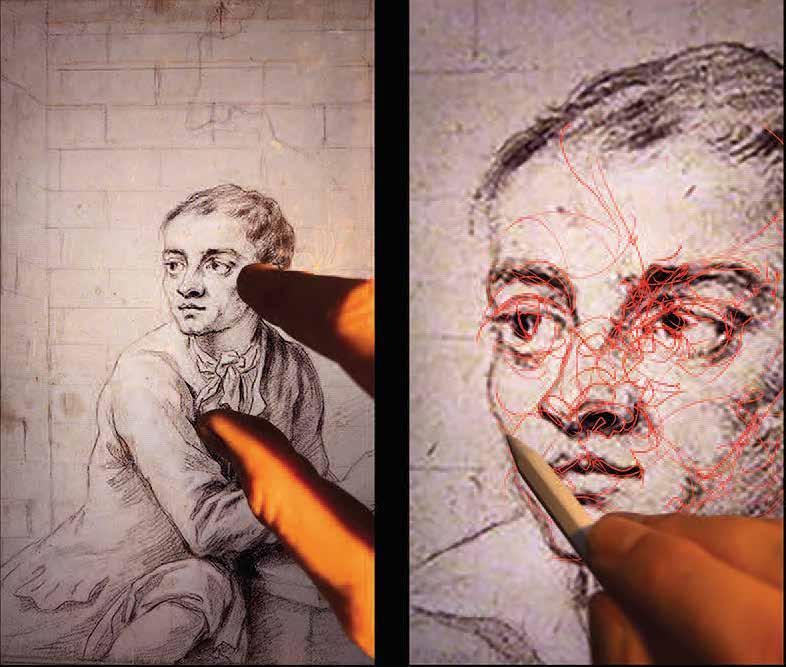


QR code for short film and ballad



Source:
Singer: Giles Lewin
Jack Sheppard (4 March 1702 – 16 November 1724) was an English criminal who became notorious in early eighteenth century London. The ‘Hundreds of Drury’ was the ‘red-light zone’ situated in streets and alleys around Drury Lane, adjacent to St Giles rookery.
To the Hundreds of Drury I write, And the rest of my flashy companions, To the buttocks that pad it all night
To pimps whores bawds and their stallions
To those that are down in the whit Rattling their darbies with pleasure, Who laugh at the rum culls they’ve bit, While here they are snacking their treasure.
This time I expect to be nubb’d
My duds are grown wondrous seedy I pray you now send me some bub, A bottle or two, to the needy. I beg you won’t bring it yourself The hangman is at the Old Bailey I’d rather you’d send it by half For, if they twig you, they’ll nail you.
Moll Spriggins came here t’other night, She tipp’d us a jorum of diddle, Garnish is the prison’rs delight, We footed away to the fiddle, Her fortune at diving, did fail, For which she had chang’d habitation But now the whore pads in the jail And laughs at the fools of the nation.
This time I expect no reprieve, The sheriff’s come down with the warrants, An account now behind us we leave
Of our friends, education and parents, Our bolts are knock’d off in the whit, Our friends to die penitent pray us, The Nubbing cull pops from the pit And into the tumbril conveys us.
Through the streets as our wheels slowly move The toll of the death bell dismays us, With nosegays and gloves we are decked, So trim and so gay they array us, The passage all crowded we see, With maidens that move us with pity; Our air all admiring, agree Such lads are not left in the City.
Oh! then to the tree I must go, The judge he has ordered that sentence. And then comes a gownsman you know, And tells a dull tale of repentance, By the gullet we’re ty’d very tight, We beg all spectators, pray for us, Our peepers are hid from the light, The tumbril shoves off and we morrice.


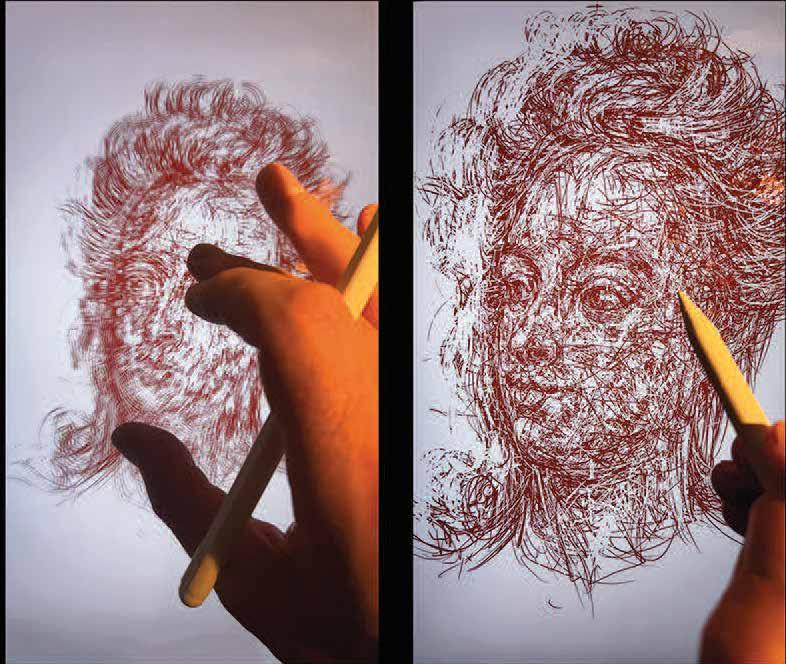
QR code for short film and ballad


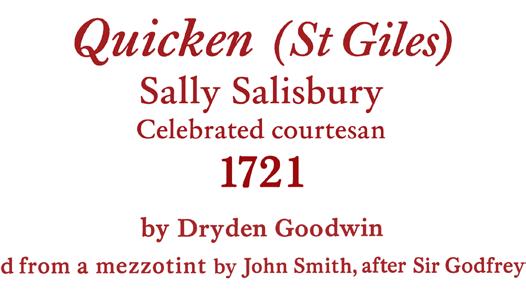
Printer: J. Pitts, No. 14, Great Saint Andrew Street, Seven Dials
Singer: Vivien Ellis
Sarah Pridden (c. 1692-1724), later known as Sally Salisbury, was a celebrated prostitute in 18th-century London. She lived in St Giles and inspired a number of biographies, songs, ballads and artworks.
Of all the girls of Venus game
Never was one that had such fame, For lords and knights of high degree
Repair to Sally Salisbury
The place I take of ladies bright I with their lords lie every night, I please them with my humour free, O the charming Sally Salisbury.
I with my loose and wanton charms
Delude their heroes to my arms If they bring gold, they may be free To the charming Sally Salisbury.
I dress in gold and silver bright, Which is adorning to the sight, Just like a lady of high degree O the charming Sally Salisbury.
My footman likewise to attend That I may for my Lovers send I touch with none but quality O the charming Sally Salisbury.
My sisters of the calling sure They by no means could me endure For their best lovers came to me, O the charming Sally Salisbury.
There are many too that will lie down For a poor teaster or half-acrown, But let them bring their gold to me, O the charming Sally Salisbury.
But I have eclipsed my morning sun By which I fear I am undone, I wounded him that loved me O the charming Sally Salisbury.
Curs’d be the knife that gave the blow, Which caus’d his precious blood to flow, To die for him I could be free O the charming Sally Salisbury.
See how the beaux in coaches Ride, To Newgate, where poor Sally lies, The lawyers flock there for their fees To the charming Sally Salisbury.
But if I swing, what can I say Did ever girl live life more gay, I touch with none but quality O the charming Sally Salisbury



QR code for short film and ballad



Source: Bodleian Library ballad archive
Singer: Giles Lewin
William Cuffay (1788 – 1870) was born in what is now Gillingham in Kent, to an English woman called Juliana Fox, and a man of African heritage, Chatham Cuffay, who was previously enslaved and originally from St Kitts. He rose to a position of leadership in the Chartist movement, and in April 1848 he helped to organise the Chartist’s Great Meeting on Kennington Common.
Music and song played an important role in Chartism and many ballads were printed in Seven Dials, which was a mustering point for an uprising in August 1848. Cuffay’s leadership highlighted the importance of Black individuals within the Chartist movement, and he was a vocal figure in his time, until he was arrested and transported to Tasmania for treason.
What a row and a rumpus there is I declare, Tens of thousands are flocking everywhere, To petition the Parliament, onward they steer, The Chartists are coming, oh dear, oh dear. To demand equal justice, their freedom and right, Pump-handles and broomsticks, lawk, how they can fight!
The nation, they say, is overwhelmed with grief: A peck-loaf for two pence and four pounds of beef.
Chorus: Hurrah for old England and liberty sweet, The land that we live in and plenty to eat; We shall ever remember this wonderful day, The Chartists are coming, get out of the way.
Such a number together was never yet seen, Hurrah for the Charter and God save the Queen! And when that the Charter old England has got, We’ll have stunning good beer at three halfpence a pot.
A loaf for a penny, a pig for a crown, And gunpowder tea at five farthings a pound; Instead of red herrings we’ll live on fat geese, And lots of young women at two pence apiece.
The bakers and grocers, look how they do laugh, With dustmen and coal-heavers, armed with a staff.
Five thousand old women, oh, how they do sing, With frying-pans, fenders, and big rolling pins. There’s Russell and Bobby, old Nosey and Hume, With pistols and bayonets, big muskets and brooms,
Load away, fire away, and chatter and jaw, Shoot at a donkey and knock down a crow.
See the lads of old Erin for liberty crow, Repeal of the Union and Erin-go-bragh! Peace and contentment, then none can we blame, Plenty of labour and paid for the same; Some are rolling in riches and luxury too, While millions are starving, with nothing to do; Through the nation prosperity soon will be seen, Hurrah for the charter, and God save the Queen!
There were thirteen old ladies, as you may suppose,
On last Monday morning got shot in the nose; One swallowed the charter as she went in the throngs,
And one ate a broomstick eleven feet long; Go along Jemmy, see the charter there goes; I say Mr. Spooner, get off of my toes; See Feargus O’Connor along for to roll, With Nottingham Castle stuck up on a pole.
To Kennington Common in droves they repair, ‘Cause Smith O’Brien and Feargus are there, A-telling the story would reach, sir, indeed, From the Land’s End of England to Berwick on Tweed.
The Charter, the Charter, or England shall quake, I wish they may get it, and no grand mistake, The Feargus shall be a prime minister keen, And Smith O’Brien a page to the Queen.



QR code for short film and ballad



Reading: Of children sent out as street sellers by their parents
From: ‘London Labour and the London Poor’
Volume 1, Henry Mayhew, 1861
Reader: Vivien Ellis
Henry Mayhew was a London journalist who observed, documented and described lives of working people in London.
From one little girl I had the following account. She was then selling boot-laces and offered them most perseveringly. She was turned nine, she said, and had sold things in the streets for two years past, but not regularly. The father got his living in the streets by “playing;” she seemed reluctant to talk about his avocation, but I found that he was sometimes a street- musician, or street-performer, and sometimes sung or recited in public houses, and having “seen better days,” ……… The mother earned 2s. or 2s. 6d. weekly, in shoe-binding, when she had employment, which was three weeks out of four, and a son of thirteen earned what was sufficient to maintain him as an (occasional) assistant in a wholesale pottery, or rather pot-shop. “It’s in the winter, sir, when things are far worst with us. Father can make very little then—but I don’t know what he earns exactly at any time—and though mother has more work then, there’s fire and candle to pay for. We were very badly off last winter, and worse, I think, the winter before. Father sometimes came home and had made nothing, and if mother had no work in hand we went to bed to save fire and candle, if it was ever so soon. Father would die afore he would let mother take as much as a loaf from the parish. I was sent out to sell nuts first: ‘If it’s only 1d. you make,’ mother said, ‘it’s a good piece of bread.’ I didn’t mind being sent out. I knew children that sold things in the streets. Perhaps I liked it better than staying at home without a fire and with nothing to do, and if I went out I saw other children busy.


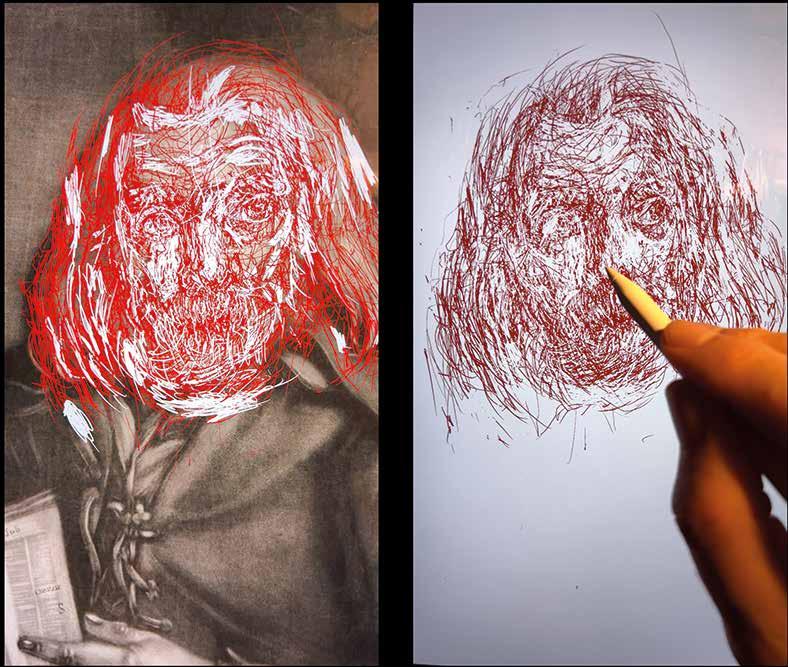
QR code for short film and reading



By: John Thomas Smith
Reader: Giles Lewin
Simon Eedy, known as Old Simon, (c. 1709-18 May 1783) lived in “Rats’ Castle” in the rookery of Dyott Street. He would spend his days outside the churchyard of St Giles-in-the-Fields and was a wellknown figure, portrayed by artists including John Seago and Thomas Rowlandson.
One of the numerous subjects which I drew this year for Mr. Crowle, was the old brick gateway entrance to St. Giles’s churchyard, then standing opposite to Mr. Remnent’s timber-yard, in which drawing I introduced the figure of old Simon, a very remarkable beggar, who, together with his dog, generally took their station against one of the gate-piers. This man, who wore several hats, at the same time suffered his beard to grow, which was of a dirty yellow-white. Upon his fingers were numerous brass rings. He had several waistcoats, and as many coats, increasing in size, so that he was enabled by the extent of the uppermost garment to cover the greater part of the bundles, containing rags of various colours; and distinct parcels with which he was girded about, consisting of books, canisters containing bread, cheese, and other articles of food; matches, a tinder-box, and meat for his dog; cuttings of curious events from old newspapers; scraps from Fox’s Book of Martyrs, and three or four dog’s-eared and greasy thumbed numbers of the Gentleman’s Magazine. From these and such like productions he gained a great part of the information with which he sometimes entertained those persons who stopped to look at him.
When I knew him,—for he was one of my pensioners,—he and his dog lodged under a staircase in an old shattered building called “Rats’ Castle,” in Dyot Street. Dyot Street has disappeared, and George Street is built on its site. His walks extended to the entrances only of the adjacent streets, whither he either went to make a purchase at the baker’s or the cook’s shops. Rowlandson drew and etched him several times; in one instance Simon had a female placed before him, which the artist called “Simon and Iphigenia.” There is a large whole-length print of him, published by John Seago, with the following inscription: Simon Edy, born at Woodford, near Thrapston, Northamptonshire, in 1709: died May 18, 1783.
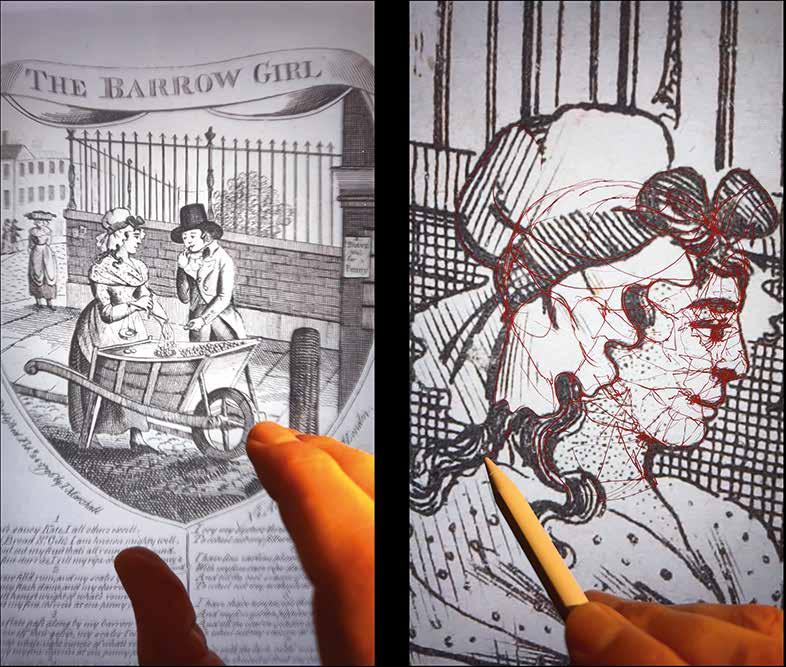


QR code for short film and ballad



Ballad: The Barrow Girl
Source: London Museum, published on February 24 1796 by John Marshall at 4 Aldermary Churchyard, St Pauls
Singer: Vivien Ellis
Street sellers were a constant presence on the streets of St Giles and central London. ‘Saucy Kate’ is a ‘coster-girl’, a familiar figure wheeling her barrow through St Giles, and attracting customers with her melodic cries.
My name’s saucy Kate I all others excell, And thro’ Broad St Giles I am known mighty well, When I wheel out my fruit that’s all round and sound I cry my fine cherries, one penny a pound.
When the flats pass along by my barrow they stand, And throw off their gossip, my scales I can slang So they nap whole eight ounces of what’s round and sound, Who’ll buy my fine cherries at one penny a pound?
When the season for cherries is over and gone, With my shallow I go to the gate every morn, I cry my oysters three a penny, till the season comes round, To wheel out my filberts at one sixpence a pound.
I have fine earline plums next in comes for to cry, With my fine rare ripe damsons for those that will buy, And till the cool season of autumn comes round, To wheel out my walnuts at ten a penny all round. I have choice nonpareils through the winter to cry And my fine golden pippins for those that will buy, And till the warm season of spring it comes round, To wheel out my raisins at two pence a pound.
I rise with the lark to the market repair, And the choicest of fruit my barrow shall bear, And till the warm season of spring it comes round, To wheel out my raisins at twopence per pound.
By Jessica Wall
This summer, Bloomsbury Festival offered the fantastic opportunity to participate in a series of drawing masterclasses. The short course of four sessions would culminate in an outdoor exhibition at the festival this October. The lively group consisted of art students who were all volunteers from a variety of art schools in London with additional volunteers from the ballad research group continuing their multi-disciplinary exploration of the streets of Bloomsbury
Before the first session, participants were invited to spend time around Bloomsbury and notice what is distinctive, what is obvious and what is more subtle about it and what contrasts there were.
The sessions were a mixture of exercises, such as describing your journey to City Lit in one continuous line which got the hand and mind flowing, and more free form working on projects while being able to exchange ideas and knowledge. Everyone was very generous in sharing opinions and expertise. Drawing, especially buildings, has very technical elements and that was addressed in a rundown of ways to depict different textures through cross-hatching and other pen or pencil techniques.
The highlight of the course was a trip to the British Museum’s reading rooms where we got to look at materials brought from their vaults from the era we were concerned with (18th century, Hogarth times). Tucked away through the sweltering and heaving summer holiday crowds, these beautiful rooms are available to anyone who wishes to request a meeting with a resource of their choice from the museum’s extensive print and drawing archive. It’s an excellent resource.
The etchings and drawings chosen were pungent depictions of life on the city streets, a raucous cacophony of quotidian dramas, heaving cleavages and bare knuckle boxing. The street scenes are
chaotic moments of larger untold stories resting in the pen strokes waiting for a viewer’s imagination to bring them to life again. What does that key that this young lady is spiriting out of the hands of her suitor open? Why is this man so implacable in the face of a woman beseechingly waving a handkerchief at him? Did those men running away from the giant snake they disturbed in the grassland of a far flung land escape it? What did the small gremlin like cat observing the opium smokers make of his lot?
We were invited to look at details and sketch them. Each of the chosen pieces were very detailed, so there was plenty to pick out and sketch depending on your interest and the allotted time went very quickly with so much to look at and consider.
Following the session, the group decamped to a nearby pub and exchanged sketches and impressions over nibbles. What details had caught their eye, which of the pieces had they been drawn to? I loved seeing other people's work, each individual hand and eye taking different takes things from the same sources. I discovered in this course that sharing sketches can feel surprisingly exposing. Sharing ideas or work in progress feels like sharing a corner of your mind, at least to me. Creativity needs courage.
Towards the end of the gathering two of the youngest of the all-female group, comrades in pencil, sat casually sketching each other for fun, which made it feel like a salon for female creativity had broken out. Inspired, the group dispersed through the Bloomsbury summer streets, to meet again with their finished pieces on show.
By Soph Wolfson
This public art project has been organised by the Bloomsbury Festival in collaboration with City Lit. Art students from across London created work in response to historic depictions of life in the area and their own experiences walking the streets of St Giles and Bloomsbury.
I’m Soph Wolfson, an illustrator, animator and art tutor with a longtime interest in early political cartoons as well as traditional illustration techniques. I’d recently started working at City Lit, the adult education college based in Holborn, when the opportunity to lead a series of masterclasses on Dickensian era prints and drawings of London, alongside the renowned artist Dryden Goodwin, presented itself and I jumped at the chance to get involved. My role on the project was to help the artists explore their interests, realise their ideas and to give them an introduction to the artwork, techniques and political backdrop of the time.
This was a period of industrial revolution, where Bloomsbury was highly populated and the economic disparity between its residents was stark. It was also a time when print made art more easily available to people across the economic divide, and so depictions of working
people, their daily lives and struggles, were much more common. Rosemary and Catríona from the Bloomsbury Festival organised for us to view some of these original prints and cartoon sketches at the Prints and Drawings Room in the British Museum.
Bloomsbury today is a hub for academic and medical institutions as well as museums and tourist attractions. Many of the historic structures have been preserved but are jammed up next to sleek, brightly coloured modern buildings. The inequality of London is still visible, with homeless people, uniformed workers and well dressed tourists with designer shopping bags crossing each other in the street. I was keen for the participants to bring these contrasts together, but also to find parallels between the lives of Bloomsbury’s residents past and present.
I learnt a lot from being a part of the Streets of Bloomsbury and St Giles project and felt wonderfully supported by the Bloomsbury Festival team. And the participants were totally committed from the start. Each of them had their own area of interest for the project as well as unique artistic styles and this has made for a compelling exhibition.
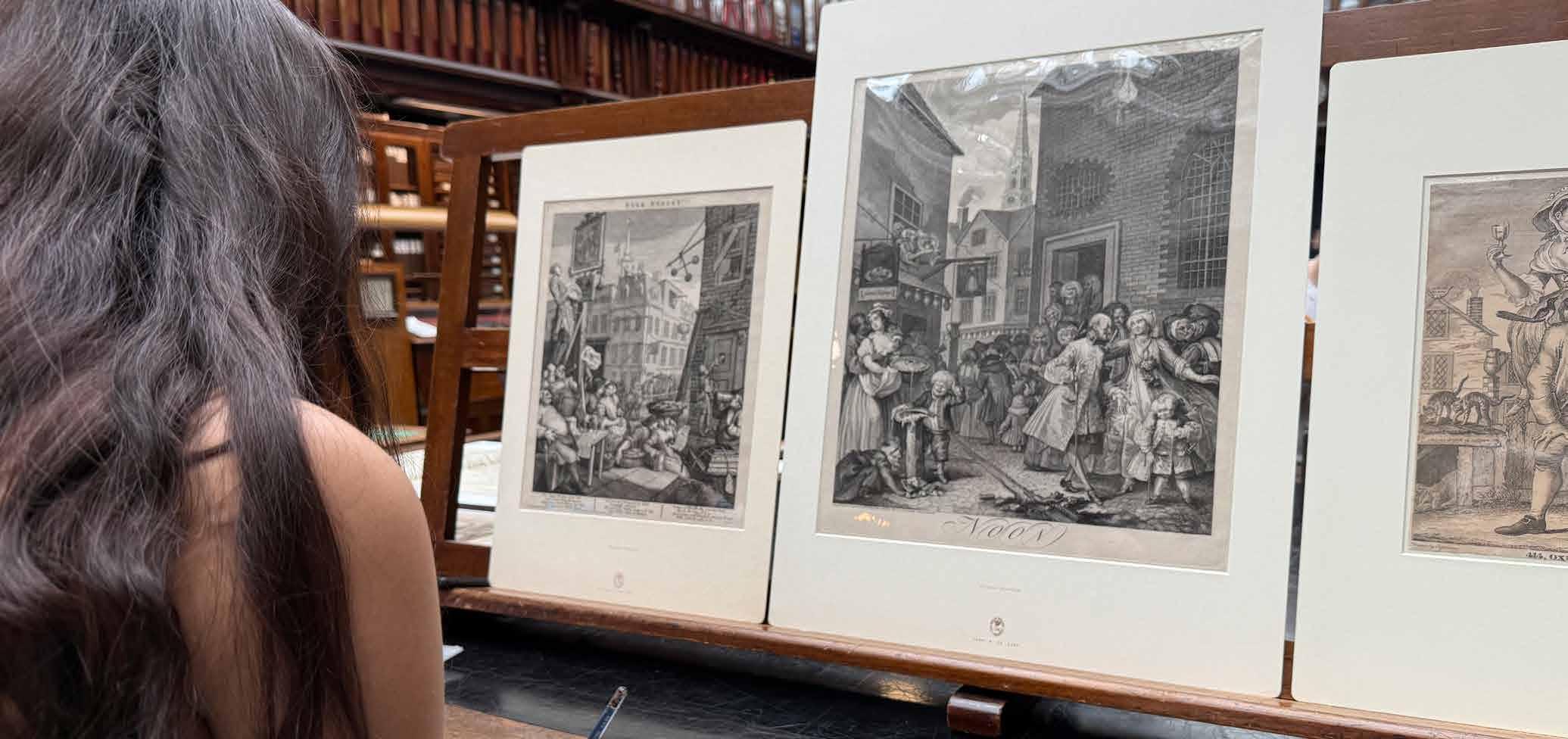
Anna’s work concerns the overlap between illustration and sonic art. She explores the melding of past and present in areas which no longer exist, or have changed so drastically that the foundational memory exists only in archive.
“In our research of past centuries in Bloomsbury and St Giles, we encountered ballad tales of demolished neighbourhoods and their poorly documented inhabitants, and artistic records of architecture and community.
We were able, as part of this project, to reach out and access materials like the catalogue of the British Museum, and the incredible knowledge of my fellow participants.
I hoped to echo some of the techniques we encountered and honour elements that join and separate the London of then and now.
Look out for the moments I have illustrated in Discrepancies in Confluence and see where you spot related scenes of daily life now on the streets of the area.”
Anna studied Fine Art at Kingston University.

Asha responds to the ballad ‘The Mournful Lovers,’ more commonly known as ‘The Unquiet Grave.’ It depicts a woman leaning against a tree, lamenting her loss, and how her excessive grief disturbs the spirit of the dead. St Giles-in-the Fields church looms in the background.
“Done in pen, I attempted to emulate the cross-hatching style we looked at in earlier artworks as inspiration.
Through this response, I seek to bring attention to how these communal beliefs ring as true in the modern time as they did in historical London by illustrating the ballad. The mid-18th century woman remains fixed at her place by her lover’s grave, as the world moves on around her. St Giles-in-the-Fields church is a symbol of continuity from London’s past amidst an ever-changing urban landscape.”
Asha is a student at UCL, and she volunteered on the music research part of the project prior to attending the art masterclasses.

Hannah’s work for The Streets of Bloomsbury and St Giles drifts between what is heard today and what is imagined from the past, between what stands before us and what has been worn away. History remains all around us. It is in the rhythm of footsteps, the outlines of buildings, the way sound catches between walls.
“The first piece listens for the sounds that can no longer be recorded; voices drifting through the air, ballads sung at street corners, the jangle of carriage wheels on cobblestones, music spilling from an open window, cries rising and falling, the restless murmur of a city growing.
These fragments meet the present-day chorus of buses rumbling, bicycles scattering across streets, engines pressing forward, conversations carried in passing. Ink gathers them together: curves and gestures rise and overlap like echoes, marks carry pitch or weight, colour breaking through like a sudden voice in the crowd.
The second piece listens instead to stone and brick as a record of time. Brick-like strata rising from the ground, shifting and reshaping as the city demands. Torn and layered papers build into surfaces that twist and collide, their edges unsettled, their textures restless. These forms resist the neat order of a brick wall, speaking instead of change, rupture, and renewal. Each layer carries its own memory: the grit and press of the Rookery, the soot that blackened the workhouse walls, the warmth of red brick terraces, the pale dust of stone. Together they hold the weight of what has been buried and the shimmer of what still pushes forward, fragments of history pressed close enough to touch.
Together, the works reimagine sound and structure, finding in both the restless chorus of a place that never falls silent, if we pause long enough to listen and look.”
Hannah was a student at City Lit studying Extended Drawing and Making.

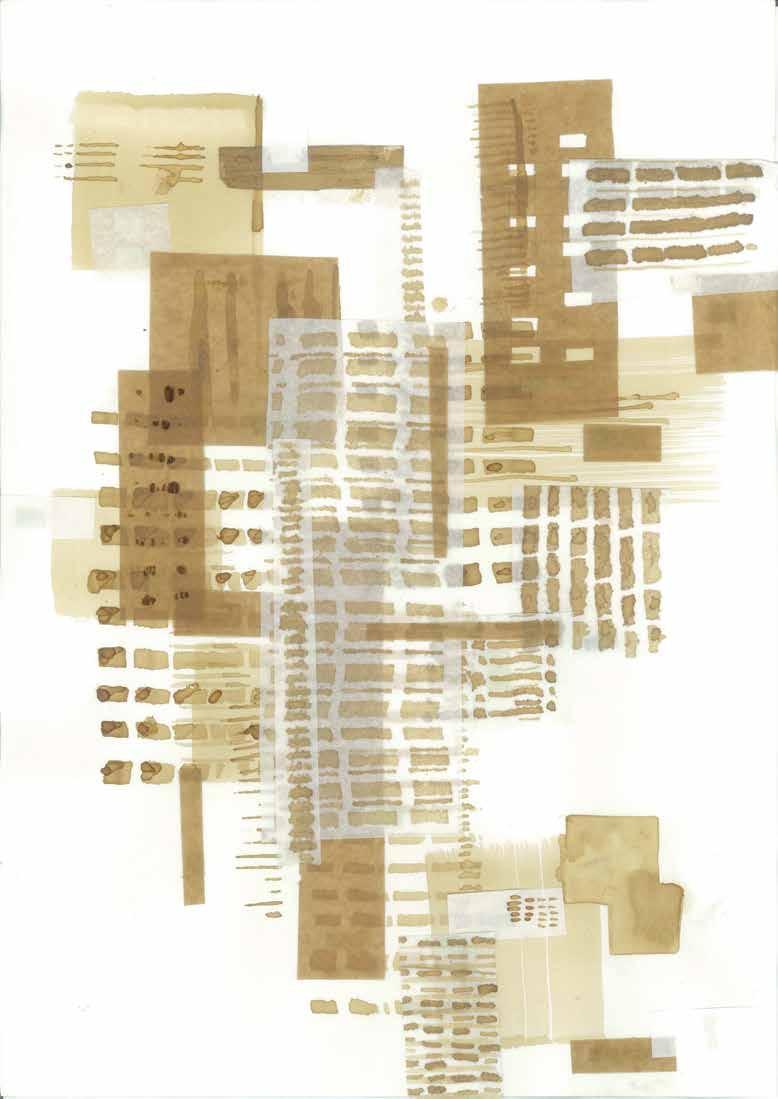
Hilary, a textiles and mixed media artist, explored the diverse locations of St Giles in Bloomsbury, immersing herself in its vibrant street life, historic architecture, and dynamic urban energy.
“My creative process was rooted in direct engagement with the area, sketching and collaging scenes, capturing moments with my analogue Pentax camera, and absorbing the atmosphere through observation. A highlight of my research was studying William Hogarth’s prints at the British Museum, which deepened my understanding of the social history and visual storytelling embedded in the locale. These experiences informed the development of my pieces, The Hustle and Bustle, Outside the Angel Pub and A Dialogue Between Past and Present, St Giles Workhouse, Dudley Court, Endell Street, London.”
Hilary studies MA Fine Art at Middlesex University.
Photo of The Angel Pub, St Giles High Street
by Hilary Wilson
The Hustle and Bustle, Outside the Angel Pub; A3, stitch on cloth (right), is rendered through machine stitch in black thread, creating a striking linear composition that evokes both movement and narrative.
Inspired by William Hogarth’s Gin Lane (1751) and the layered history of The Angel Pub, formerly known as ‘The Bowl’, where condemned men were once brought by horse and cart to drink strong ale from a wooden bowl, the work reimagines this site in a contemporary context. Instead of a cart, a London bus now arrives, dropping off visitors and locals who come to work, shop, or drink outside the pub. Through thread and texture, this piece captures the evolving spirit of the location, blending historical echoes with the rhythms of modern city life.


Reflects on the transformation of a onceinstitutional space into modern residential flats at Dudley Court, Endell Street, London. Inspired by the absence of the original workhouse and the lives once lived within its walls, one can imagine the conversations that might have taken place there, echoes of hardship, resilience, and community, juxtaposed with the everyday exchanges of contemporary residents. Drawing from Professor Dryden Goodwin and Soph Wolfson’s masterclass and the intricate hatching and mark-making techniques of William Hogarth, this weaves together historical memory and present-day reality. The work becomes a layered meditation on time, place, and the voices that linger in urban spaces long after their physical traces have vanished.

Isabel has taken as her starting point the people she observes on the streets of London. She takes inspiration from the historic illustrations of St Giles and Seven Dials, creating new print artworks.
“I’m from South America, Chile, living in the UK, and to me the idea of immigration and visitors in the city is interesting. The main theme for me was people, suffering in poor conditions, and the tourists nowadays in London, roaming around the city. I took photos and then I did linocuts trying to include families and tourists.”
Isabel is studying art at City Lit.

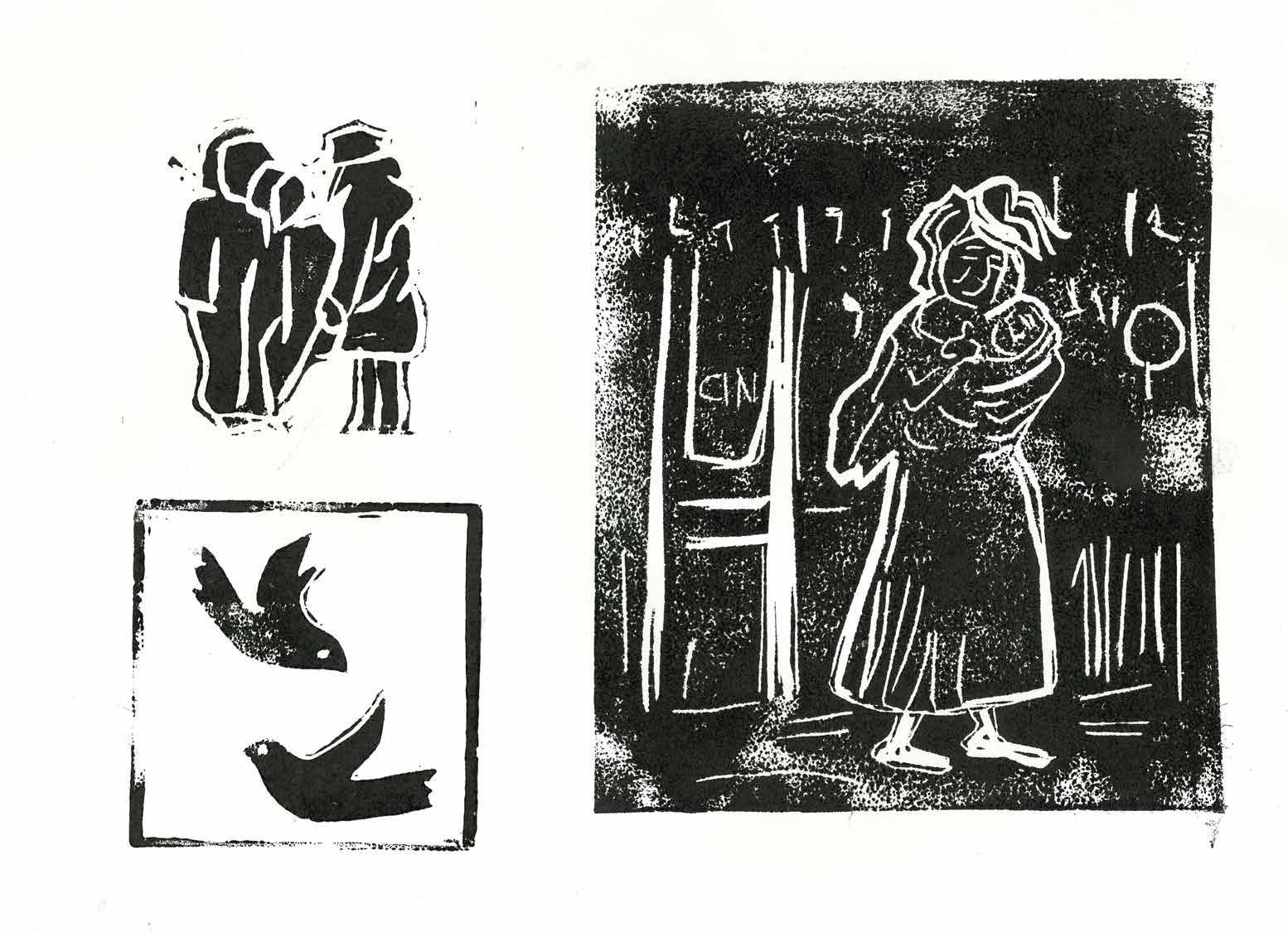
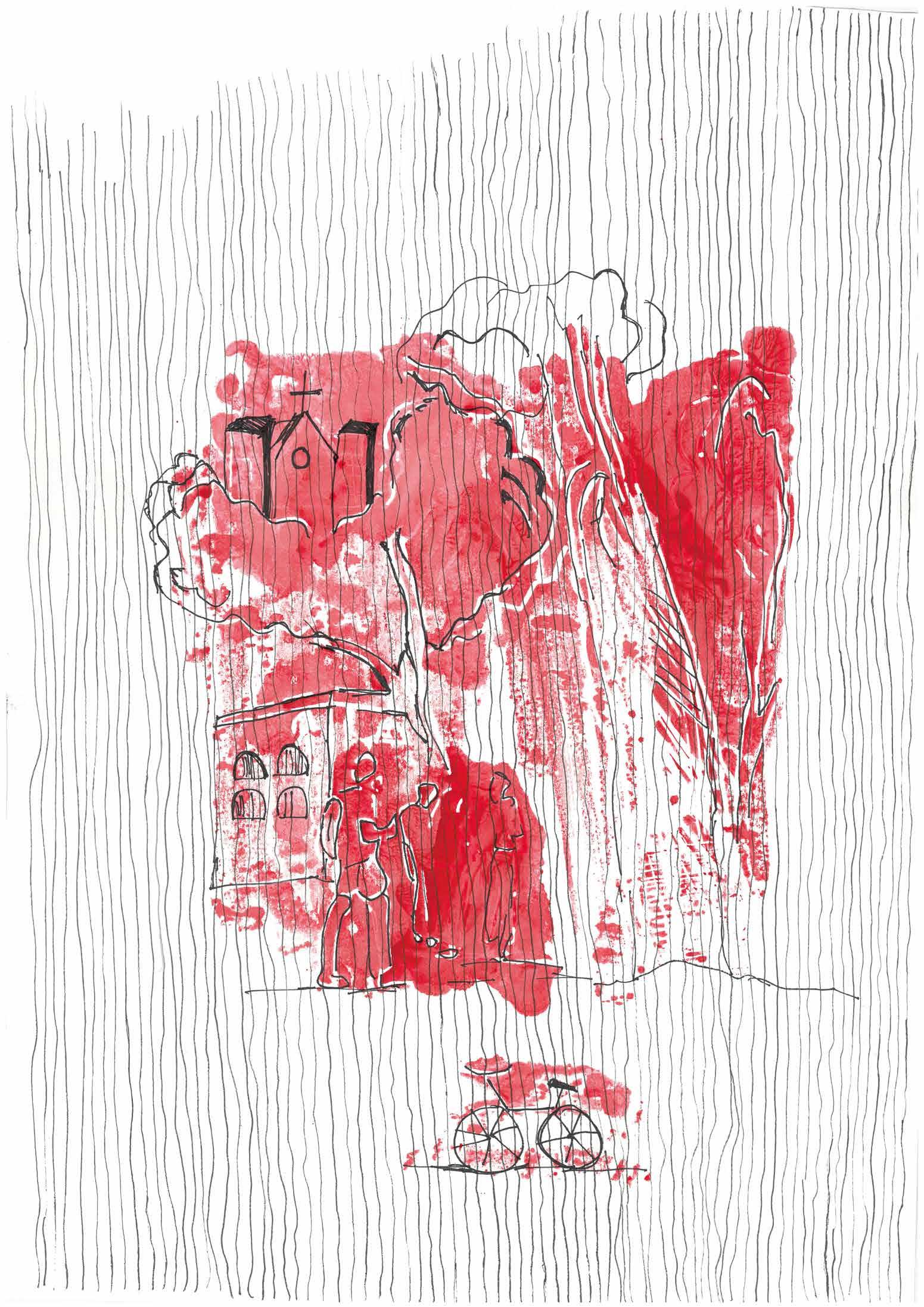
Jane’s art practice experiments with forms and textures to evoke multiple strands or layers of meanings, associations, and ideas. She is drawn to the familiar and everyday elements of our environments: the things that we take for granted, but which carry both the stories of their creation and of the people who passed this way before us.
“My site research was conducted on a beautiful sunny day. As I sat in Lincoln Inn’s Fields, I realised that this wasn’t the London that the people of the past knew. Searching for information on historical pollution, I found a wealth of references. From Elizabeth I’s disgust at the qualities of coal smoke, via the “London Ivy” and soot snowflakes of Dickens, to the killer Great Smog of 1952, complaints about the unwholesome atmosphere are repeated across the centuries.”
Jane studies art at City Lit.

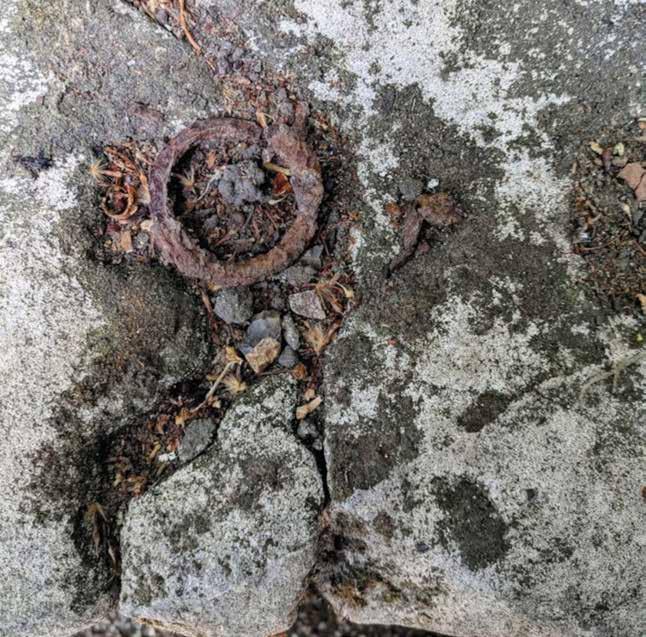

Whilst exploring contemporary depictions, I came across a quote from Monet:
“What I like most of all in London is the fog. How could English painters of the nineteenth century have painted its houses brick by brick? Those fellows painted bricks they didn’t see, bricks they could not see.”
This led me to wonder what the city would look like if our air quality changed and the infamous “pea souper” returned.
Once I’d chosen a site, I gathered my materials. I was unbelievably fortunate to find an original 18th century Act of Parliament that was not only about the use of coal in London, but specifically referred to the parish of St Giles-in-the-Fields to use as my paper.
I found media with pigments from relevant sources (e.g. Georgian yellow bricks, forge soot, rust from an object I found in the area), and experimented with combining and layering these to create something that contains both the old and new, the real and imagined.
Photos: Rust used for pigment

St Giles Court Through a London Particular by Jane CaseyMiller; 324x195mm Torrit Grey Gamblin oil paint (with pigment dust from factory filter), Georgian Yellow Brick London Pigment, rust (from metal object found on the boundary of Lincoln’s Inn Fields), Cornelissen Historical Inks Forge Lamp Black (contains soot harvested from a working 19thcentury forge, powered by charcoal and wood), charcoal, pastels
Naomi is a multi disciplinary artist. Her digital drawings for this exhibition explore ideas of place and time.
“The spaces we inhabit can have a lasting affect on life chances, as well as on how we see ourselves.”
“The site where the Central St Giles development now stands used to be the worst slum in London. This idea of one starting point taking two paths to different moods is like parallel keys in music theory. I am interested in what this says about place and nostalgia, progress and people feeling disregarded.”
Naomi studies fine art at City Lit.


On the Beaten Track; Digital, 1371mm x 1485mm
On the Beaten Track is inspired by old tiles at The Angel pub and contemporary architectural features around Central St Giles.
“I am fascinated by the role patterns play in nature and in human experience, as well by the tendency to overlook and disappear things into the background. Creating a wallpaper felt like a good way to combine both ideas.”
Under the Sun; Digital 1399.96mm x 1399.96mm
Under the Sun combines Naomi’s drawings of 17th/18th and 21st Century gin glasses, beer mugs/ glasses and epidemic masks.
“This tile pattern is designed to question how much has changed and how much we learn from the past. Gin and beer feature heavily in old drawings of the area which is also where the Great Plague of London started.”

“Drawing has always been at the centre of my art practice, especially life drawing, but most of my drawings remain sketches, never a final piece.”
Olivia was inspired by the historic prints of carts and people in the street to compare the historic with the modern day St Giles.
Olivia studies art at Kingston University.

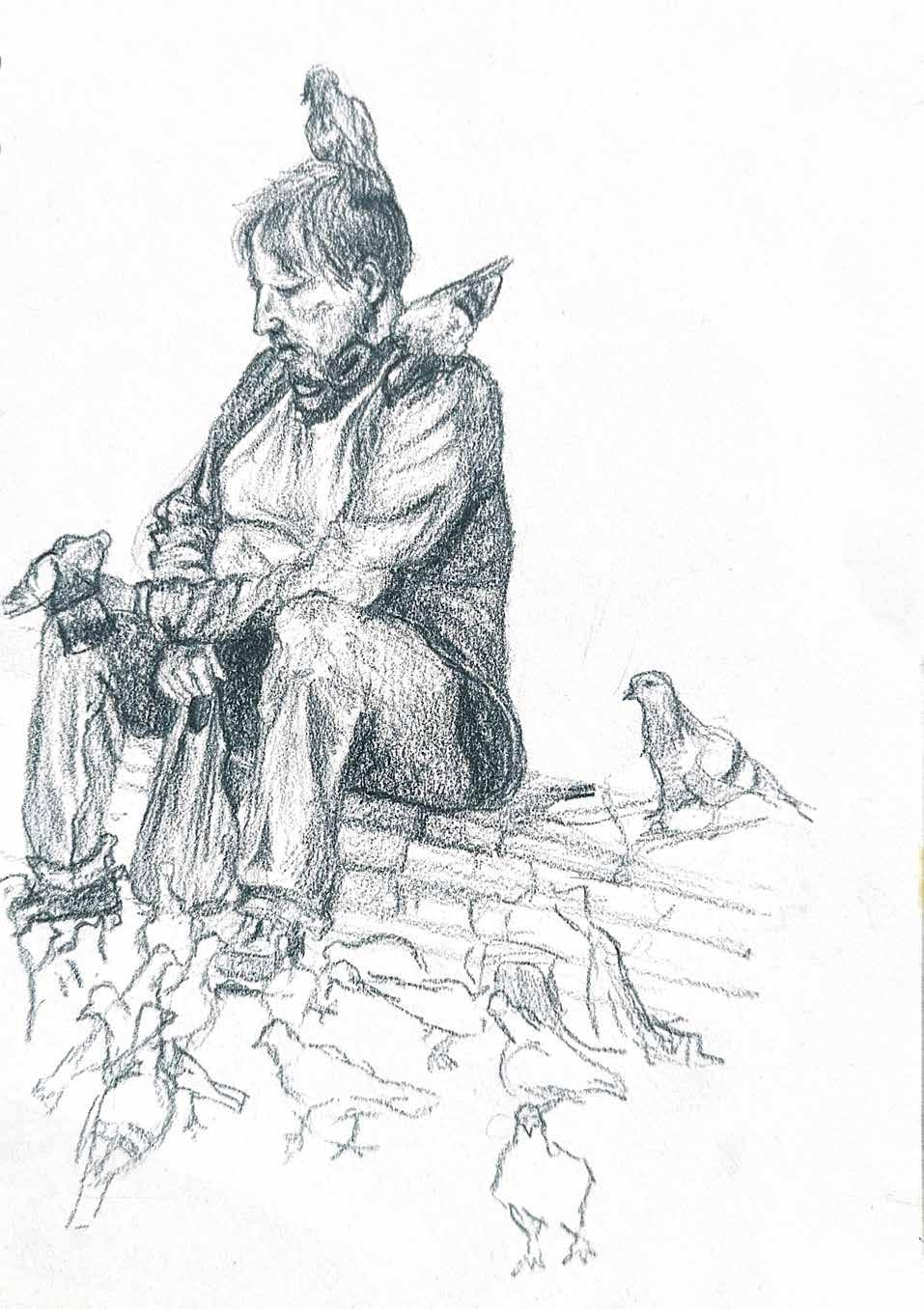
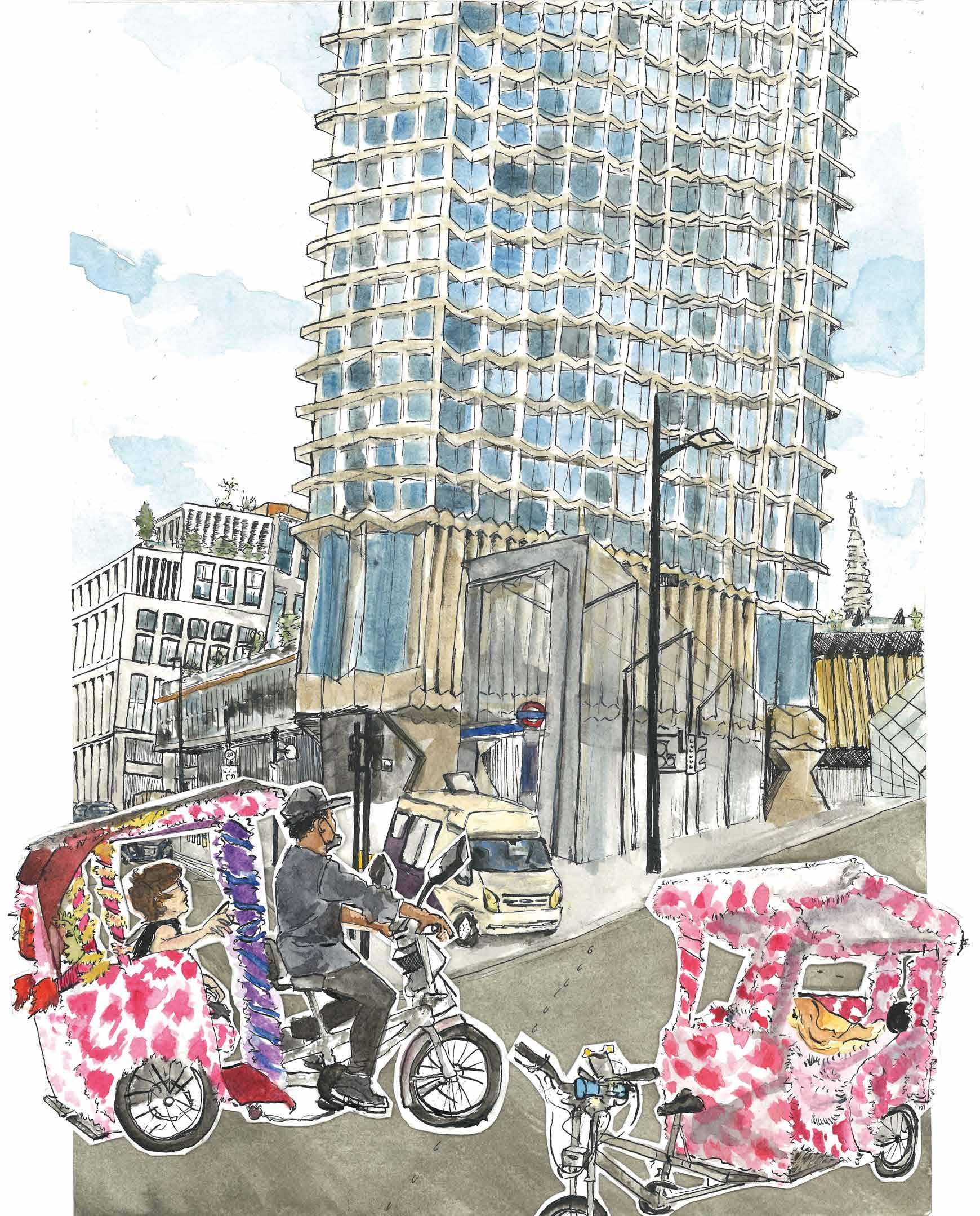
Polly’s artwork explores the collapse of boundaries between people living in the Seven Dials area and how the neighbourhood posed a challenge to the rigid division of ‘spheres’, between home and work and between genders, that the Victorians attempted to impose on Society.
“The historical illustrations that we have looked at during this project tended to depict the Seven Dials as either a place to visit for amusement, full of criminals and drunks, or as a scene of abject misery, somewhere to die of starvation and neglect. Both have basis in fact; but the Seven Dials rookery was also a hub of communication, known for its proliferation of printing businesses, it’s use of the secret language, ’St Giles’ Greek’, and the ease of word-of-mouth reporting afforded by close living conditions. It is this subversive aspect of the area that has interested me most.”
Polly originally studied history at University and is now studying on an advanced Fine Art course at City Lit.


Preparatory Sketches
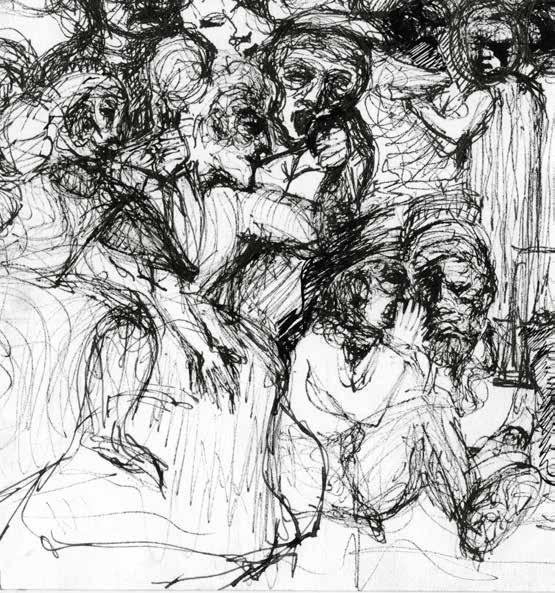


Rachel is an artist and print maker. She often works in aquatint and has just bought her own press. For this project Rachel revisited the Rookeries and Seven Dials and has drawn a series of illustrations for both.
“As I drew a wandering through the Rookeries, shadows danced in the narrow streets, cloaking the world in a mysterious embrace. The gritty pavement whispered tales of escape and hardship, a stark reminder of the poverty that clung to the corners like a forgotten secret. So close to St. Giles’ gallows, the area pulsed with a thrill, a bittersweet melody of my youth when I roamed these streets, searching for the elusive freedom that life promised.
This place, a paradox of joy and fear, has always tugged at my heart. And then there’s Seven Dials, where the vibrant hustle intertwines with moments of solitude, capturing the essence of London itself. It’s a part of the city that offers both laughter and longing, where every face tells a story, and amidst the chaos, I find a kindred spirit in the wonderful people who inhabit its depths. In this tapestry of life, I feel the intoxicating blend of excitement and isolation, forever entranced by its beauty and complexity.
I felt that I wanted this to be ageless without time without real characters but people you would have met at any age in the Rookeries. I wanted it to be filled with shadows and figures tripping along in the narrow streets, mysterious as I had in my youth. The gritty pavement filled with a thousand great nights and stories and the people that keep the area vibrant as they do to this day.”
Rachel has a degree in architecture and has just completed an advanced print course at City Lit and is now setting up her own studio.

Rookeries I by Rachel Suddaby; Collograph Lino and ink 49cm x 77cm
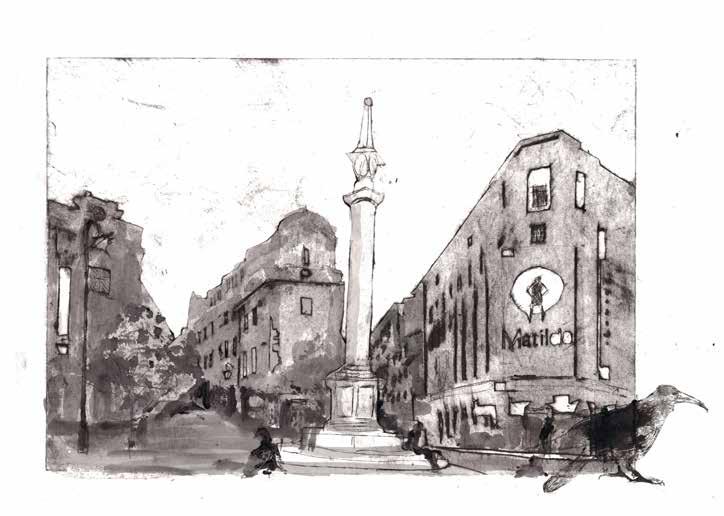

Seven Dials I and Seven Dials II by Rachel Suddaby; Collograph Lino and ink 34cm x 49cm
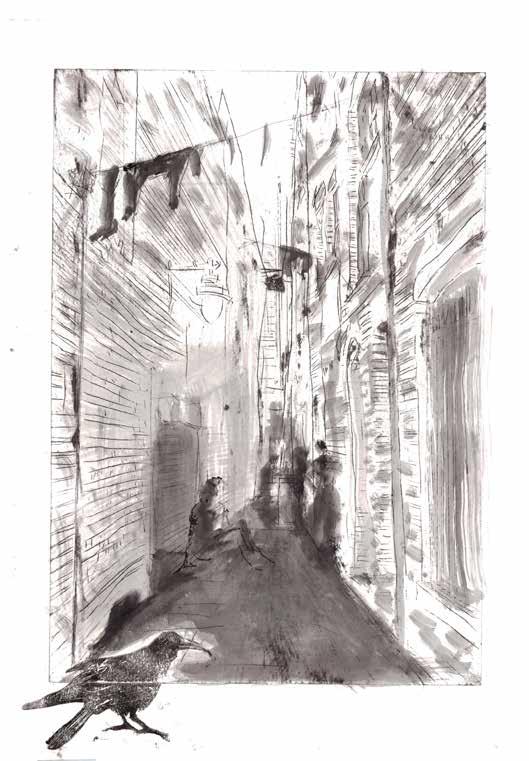
Rookeries II by Rachel Suddaby; Collograph Lino and ink 34cm x 50cm

Rookeries III by Rachel Suddaby; Collograph Lino and ink 34cm x 49cm
Thea has focused on The Rookery at St Giles, looking at historical texts and newspaper clippings, as well as drawings and etchings of the area.
“I created a partially abstract illustration reimagining The Rookery using elements from 18th and 19th Century artworks, as well as archives from the British Museum. Fragments of publicly available maps are layered into the work, while the colour palette is borrowed from Renzo Piano’s contemporary Central St Giles development, which now occupies the site of The Rookery. The scenes and characters depicted are my own interpretation, rather than direct reproductions.”
Thea Carley studied Advanced Children’s Book Illustration at City Lit.




Preparatory Sketches and photograph

Rossana’s work explores the themes of Individual Lives, Faith & Religion, focusing on how they shape personal identity and experience. As a multidisciplinary artist born in Hong Kong and based in London, drawing is central to her practice, serving as a means to translate lived experience into visual form.
“Drawing from my time in London, I investigate how the unique rules and customs of specific locations impact both individuals and communities, highlighting the emotional, material, and transformative aspects of daily life.”
The location of The Old Way is at The Angel pub in St Giles High Street. The location of In a Place of Certain Rest is the St Giles-in-theFields Church.
Rossana has recently completed her BFA in Fine Art at UCL Slade School of Fine Art (2022-2025).



a
The history of St Giles is generally synonymous with crime, prostitution, mendacity, poverty and drunkenness. Victoria has been interested in different, less well known, stories and events that reveal alternative, more positive pictures of the area and its inhabitants.
“In terms of image style, my research revealed four main types of historic imagery: architectural drawings, reportage style illustrations, maps and written sketches.These styles influenced the creation of my work.
“There are two conflicting narratives of the areacrime, poverty and degradation , and a hardworking, resilient community who loved to sing and dance.”
Victoria is studying art at City Lit.
This text was printed in collaboration with New North Press, Hoxton using 19th century poster type on a Columbian flatbed press.
Original A2, letterpress poster type, printing ink, digital scans of 1720 parish maps of St Giles, St Anns and St Martins, digitally layered to create a 140cm x 148cm digital print.
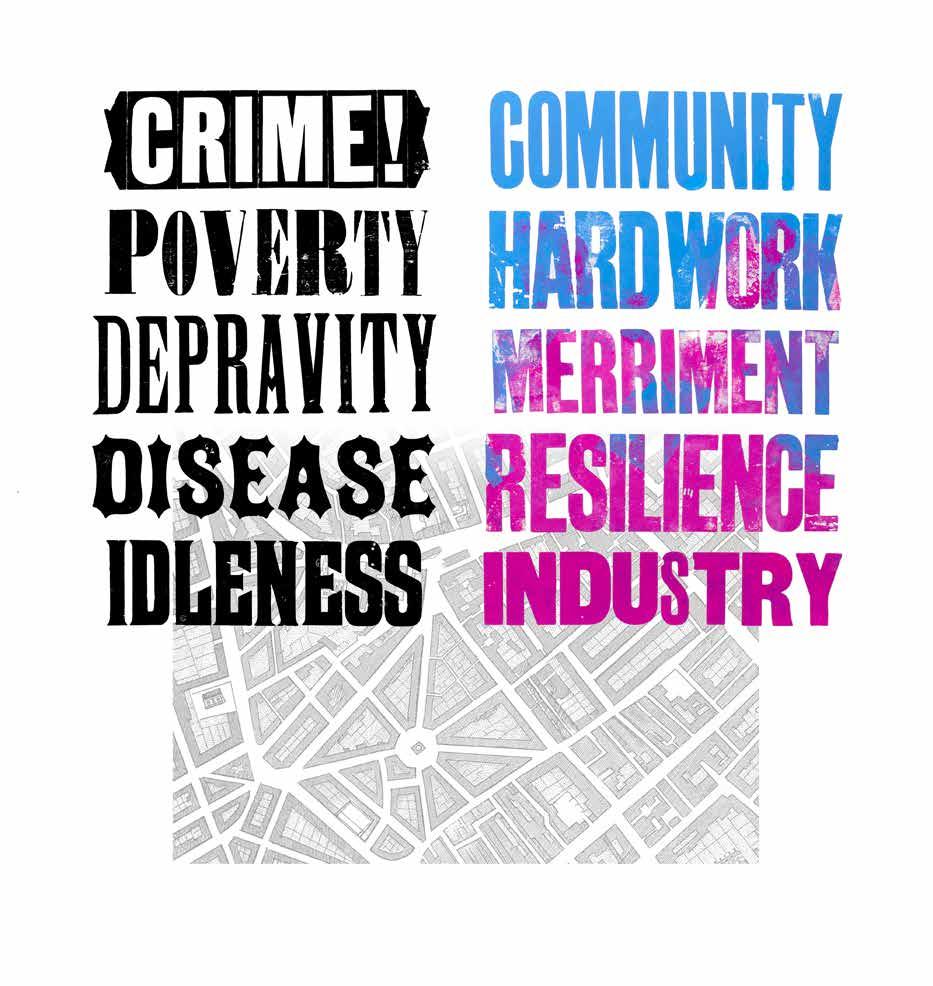


St Giles Piazza is in an area that was known as a Rookery, a term used historically to describe a colony of poor and unruly people. The area was home to a large community of labouring poor and consequently a large amount of livestock was kept in the area. In November 1761 The Public Ledger carried a story that near 500 hogs were being unlawfully kept in St Giles, some even in dwelling chambers and were causing a great nuisance to the neighbourhood. They were later seized and the money from their sale distributed to the poor of the parish.
Inspired by 18/19th century engravings of St Giles church and the ballad The way to live which was printed in what is now Monmouth Street, Seven Dials. The ballad describes some of the different ways a couple could earn a living in order to make a life together. It describes an optimistic, hardworking and resourceful pair and paints a vivid picture of the variety of trades going on in Seven Dials in the 19th century. Everything from selling fruit to fish to sausages, baking, dressmaking, cobbling, hairdressing, fortune telling and teaching the polka.
Wendy is a mixed media artist who appreciates architecture, and uses media like leaded light and other 2D and 3D media. This project has provided a personal discovery of her connections to John Wesley, the founder of Methodism, and Wesley’s connections to the Huguenot church in West Street, where he took out a lease in 1743. She also takes inspiration from another personal story relating to the Foundling Hospital, where a distant relative was left to start their life many generations ago.
“I like impressionist cityscapes and usually try to convey this through painting and drawing buildings. I took stained glass as a starting point for this project, and in particular the stained glass window illustrated. This window was moved from Bloomsbury when the Foundling Hospital relocated in 1935 to a new purpose-built school in Berkhamsted, Hertfordshire.
To create my new image I linked this with the history of Wesley and his campaigning against slavery, alongside William Wilberforce. I felt inspired to link both stories adding in the contemporary message alongside the colourful artwork reflecting the historic stained glass.
I used the technique of gel film in between two papers to create my new work.
John Wesley witnessed slavery first hand and I like to think that if he lived today he would be campaigning against the modern-day slave trade”.
is

Stained Glass Window at Ashlyns School Chapel
Moved from the Foundling Museum in 1935
Cnbrb, CC BY-SA 4.0 via Wikimedia Commons


The festival worked with artist Jane Palm-Gold to showcase her artwork relating to the area of St Giles where she lives and works. The exhibition was hosted at Camden Local Studies and Archives Centre.
By Jane Palm-Gold
In the ‘History of the London Parish’ we learn how, in the seventeenth century, St Giles grew from a semi-rural parish to a major new suburb of London. For a time it became a fashionable place to live. Aristocrats and judges vied for the new houses of Lincoln’s Inn Fields and Green Queen Street, and the Cockpit Theatre flourished in Drury Lane. St Giles acquired a fine new church of its own, as well as the elegant Bedford Square.
The years after 1800 saw a collapse in the parish’s reputation and the name of St Giles stood for the most notorious of all districts in central London for its poverty, criminality and degradation. This reputation was particularly linked with an area of dense housing north of the Church - the so-called Rookery. The area was also known as the ‘Holy Land’ and ‘the Rat’s Castle’.
Billy Waters was a famous fiddle-playing busker, who entertained patrons of the Adelphi Theatre in the 1810’s and 1820’s. It is said that he was born into slavery in America, and escaped servitude to join the Royal Navy. He lost a leg when falling from the rigging, and eventually found himself living in London, in St Giles, where he earned a living with his fiddle, singing and dancing on the streets to support his wife and children. He was a distinctive figure with his naval uniform, wooden leg and feathered hat; one of an estimated 10,000 people of African heritage making a living in England at this time.
At the end of his life he was popularly elected ‘King of the Beggars’ in the parish of St Giles, because of his fame and the regard of his peers. He became the first performer of African descent to be represented in a West End production, when a character based on him featured in ‘Tom and Jerry’, which was a box office hit. However, this false and racist portrayal destroyed his reputation and died a pauper in the workhouse of St Giles-in-the-fields in 1823. In 2023 a commemorative plaque dedicated to Billy Waters was unveiled on the corner of Dyott Street and Bucknall Street where he lived with his family in the former St Giles Rookery.


Billy Waters, Leaving George Street, St. Giles Rookery, to Work the London Streets, c.1819‘The Progress of Billy Waters, c.1819’
© Jane Palm-Gold, 2025

Billy Waters, Leaving the ‘Dials for Home‘The Progress of Billy Waters, c.1819’
© Jane Palm-Gold, 2025
Artworked prints - ‘Church Lane, St Giles 1840’ and ‘The Seven Dials’ - Camden Local Studies & Archives Centre
Front Cover Artwork: The Rookery by Thea Carley
With thanks to all our many partners on the Strange Doings in London project including
St Giles-in-the-Fields Church
Rebecca Preston and Andrew Saint Vivien Ellis
Dryden Goodwin
Soph Wolfson
All participating singers, speakers, choirs, researchers, artists and volunteers
Bloomsbury Festival team
British Library
British Museum
Camden Local Studies and Archives Centre
Camden Libraries
Charles Dickens Museum
City Lit
Dragon Cafe Singers
Jeffrey Choy
KCBNA
The Bedford Estates
UCL
University of Cambridge Library - Rare Books








